|
|
|
| My Favourite Planet > English > People > Dioskouroi |
|
| |
Dioskouroi
Ancient Greek mythology, religion and art
The mythical twin heroes, Kastor (Κάστωρ, beaver; Latin, Castor) and Polydeukes (Πολυδεύκης, much sweet wine; Latin, Polydeuces or Pollux) were known as the Dioskouroi (Greek Διόσκουροι, sons of Zeus; Latin, Dioscuri). [1]
The various versions of the myths concerning the twins are inconsistent and often vague. One twin was said to be the immortal son of the Aetolian princess Leda (Λήδα, daughter of King Thestius) and Zeus, who disguised himself as a swan to have sex with her. The other, conceived the same night, was the mortal son of Leda and her husband King Tyndareos of Sparta (Τυνδάρεως). However, which of the twins was immortal is not clear: it is generally thought that Polydeukes was the immortal son of Zeus, and Kastor the mortal son of Tyndareos.
In some versions of the myths, the coupling of Leda and Zeus as a swan (see below) produced one or two eggs, from which hatched one of the twins and Helen of Troy. [2] At the same time Leda also give birth to the other twin and Clytaemnestra (Κλυταιμνήστρα), conceived by more conventional means with Tyndareos. Helen (Ἑλένη) married Menelaos, king of Sparta, but her abduction by the Trojan prince Paris (see below) led to the Trojan War. Clytaemnestra married Menelaos' brother Agamemnon, king of Mycenae, but murdered him on his return from Troy (see below). In yet another mythological variant, it was Nemesis (Νέμεσις), the goddess of retribution, who was raped by Zeus as a swan and produced an egg from which Helen hatched. The egg was found by or given to Leda who became Helen's nurse (see image below right). [3]
The Dioskouroi were also half-brothers of Timandra, Phoebe, Herakles, and Philonoe.
The twins were closely associated with horses, often depicted as mounted warriors or hunters (such cult images of mythical horsemen were widespread among ancient cultures) and particularly revered by cavalry soldiers.
They also appeared as warriors and hunters in several mythical tales, including the hunting of the Kalydonian Boar (see photos below), the feud between Sparta and Athens following the abduction of Helen by Theseus, and the expedition of Jason and the Argonauts.
There were also tales of cattle theft (see photo below), abduction of women, rivalry, trickery and revenge involving the Dioskouroi and their cousins Lynkeus and Idas (the Apharidae, sons of Aphareus), twin brothers from Messenia [4]. The growing emnity between the two sets of twins ended with Idas ambushing and killing Kastor, and Polydeukes killing Lynkeus.
Other versions of the myths related that both the Dioskouroi were killed in combat by Lynkeus and Idas during a siege of Sparta (Lacedaemon). In the Iliad by Homer, during the siege of Troy Helen asks why her brothers are not among the Greek besiegers (Achaeans) she can see from the walls of the city. Homer tells us that, unknown to her, both were already dead and buried:
"'I see, moreover, many other Achaeans whose names I could tell you, but there are two whom I can nowhere find, Castor, breaker of horses, and Pollux the mighty boxer; they are children of my mother, and own brothers to myself. Either they have not left Lacedaemon, or else, though they have brought their ships, they will not show themselves in battle for the shame and disgrace that I have brought upon them.'
She knew not that both these heroes were already lying under the earth in their own land of Lacedaemon."
Homer, Iliad, Book 3. Translated by Samuel Butler.
After Kastor's death, Polydeukes asked Zeus to allow his twin brother share his immortality so that they could remain together. Zeus transformed them both into the stars today known as the Gemini (Latin for twins) constellation, the heavenly twins. Some ancient authors wrote that they shared immortality in turns. Even Homer, who had consigned them to beneath the earth in The Iliad, explained in The Odyssey that each was alive and then dead on alternate days:
"And I saw Lede, the wife of Tyndareus, who bore to Tyndareus two sons, stout of heart, Castor the tamer of horses, and the boxer Polydeuces. These two the earth, the giver of life, covers, albeit alive, and even in the world below they have honor from Zeus. One day they live in turn, and one day they are dead; and they have won honour like unto that of the gods."
Homer, Odyssey, Book 11, lines 298-304. At Perseus Digital Library.
They are sometimes called the Tyndaridae or Tyndarids (Τυνδαρίδαι, Tyndaridai), a reference to their father / stepfather King Tyndareos of Sparta. The worship of the Dioskouroi appears to have had its origins and centre at Sparta, where they were associated with the Spartan tradition of dual kingship, and there were many sanctuaries dedicated to the twins around the Peloponnese. The cult spread throughout the ancient Greek world, and they were also worshipped by the Etruscans (as Kastur and Pultuce), Romans and Gauls.
Two "Homeric Hymns" [5] are dedicated to the Dioskouroi, in both of which the brothers are referred to as the Tyndaridae, born to Leda below Mount Taygetos (Ταΰγετος), west of Sparta, after Zeus ("Son of Cronos") had slept with her.
"Sing, clear-voiced Muse, of Castor and Polydeuces, the Tyndaridae, who sprang from Olympian Zeus. Beneath the heights of Taygetus stately Leda bare them, when the dark-clouded Son of Cronos had privily bent her to his will.
Hail, children of Tyndareus, riders upon swift horses!"
Homeric Hymn 15, To the Dioscuri at Wikisource.
Hymn 33 also describes the role of the Dioskouroi as the protectors of seafarers, for which they were worshipped at places such as the Northern Aegean island of Thasos (see below).
"Bright-eyed Muses, tell of the Tyndaridae, the Sons of Zeus, glorious children of neat-ankled Leda, Castor the tamer of horses, and blameless Polydeuces. When Leda had lain with the dark-clouded Son of Cronos, she bare them beneath the peak of the great hill Taygetus, children who are deliverers of men on earth and of swift-going ships when stormy gales rage over the ruthless sea. Then the shipmen call upon the sons of great Zeus with vows of white lambs, going to the forepart of the prow; but the strong wind and the waves of the sea lay the ship under water, until suddenly these two are seen darting through the air on tawny wings. Forthwith they allay the blasts of the cruel winds and still the waves upon the surface of the white sea: fair signs are they and deliverance from toil. And when the shipmen see them they are glad and have rest from their pain and labour.
Hail, Tyndaridae, riders upon swift horses! Now I will remember you and another song also."
Homeric Hymn 33, To the Dioscuri at Wikisource.
The city of Tyndaris (Τυνδαρίς; also Tyndarion, Τυνδάριον; today Tindari) in northeastern Sicily was named after the Tyndaridae (Dioskouri) by refugees from the Peloponnese, Zakynthos and Naupaktos, who had been driven from Greece by the Spartans at the end of the Peloponnesian War and were resettled at the location around 396 BC the tyrant Dionysius I of Syracuse (ruled 405-367 BC). [6] It was one of the last cities in Sicily to be founded solely by Greeks. They issued coins marked TYNΔΑPΙΤΑΝ (Tyndaritan) with depictions of the Dioskouri.
The twins were also known as Anakes (Ἄνακες, kings; also translated as "protectors", "guardians" and "on high"; Plutarch, Life of Theseus, 33.1), their annual religious festival the Anakeia (Ἀνάκεια), and their temple the Anakeion (Ἀνάκειον).
There was an Anakeion beneath the Sanctuary of Aglauros on the east slope of the Athens Acropolis. Pausanias described a sculpture group and paintings dedicated to them there:
"The sanctuary of the Dioscuri is ancient. They themselves are represented as standing, while their sons are seated on horses. Here Polygnotus has painted the marriage of the daughters of Leucippus, was a part of the gods' history, but Micon those who sailed with Jason to the Colchians, and he has concentrated his attention upon Acastus and his horses."
Description of Greece, Book 1, chapter 18, section 1.
Pausanias also mentions that "at Kephale [in Attica] the chief cult is that of the Dioskouroi, for the inhabitants call them the Megaloi Theoi [Great Gods]".
Description of Greece, Book 1, chapter 31, section 1.
According to the poet and collector of epigrams Meleager of Gadara (Μελέαγρος ὁ Γαδαρεύς, 1st century BC), the cyclamen (κυκλάμινος) was named after the Dioskouroi:
"... the Muses' cyclamen which takes its name from the twin sons of Zeus." [7]
In Greek and Roman art the Dioskouroi are usually depicted as naked apart from a pilos (πῖλος) conical cap ( see Medusa), chlamys (χλαμύς, short cloak) and sometimes boots, each holding a spear and often on or with a horse. They are sometimes shown with a star above each head, particularly on coins (see coins above right and below, and a votive relief below). |
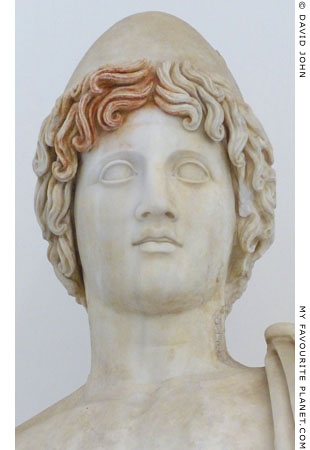
Detail of one of the Dioskouroi statues
in the Naples Archaeological Museum.
See photos below. |
| |
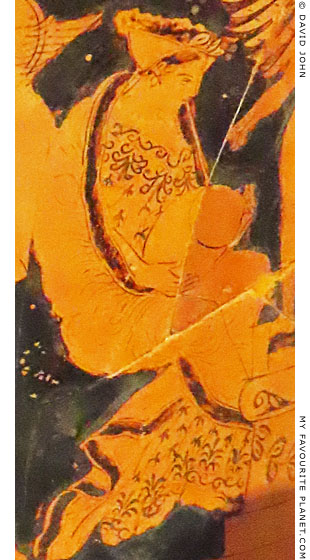
Detail of an Attic red-figure calyx-krater with
a depiction of Leda, seated and holding a
large egg from which Helen of Troy will be
hatched (see the rest of the painting on
the Hermes page).
Around 420-400 BC. Found in Ierissos
(Ιερισσός; ancient Akanthos, Ἄκανθος),
Halkidiki, Macedonia (see History of
Stageira and Olympiada - Part 1).
Thessaloniki Archaeological Museum. |
| |
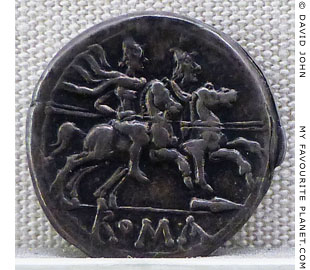
The Dioscuri on a bronze coin of
the Roman Republic, 211-170 BC.
Palazzo Massimo alle Terme,
National Museum of Rome. |
| |
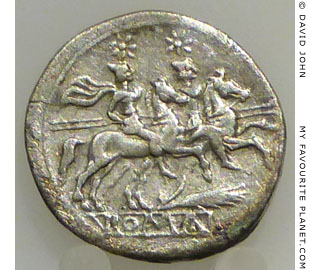
The Dioscuri on a coin of the Roman
Republic, from Akragas (Agrigento), Sicily.
Agrigento Regional Archaeological Museum. |
| |
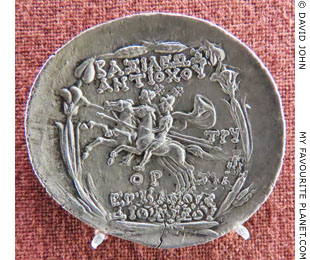
The Dioskouri on a coin of the child king
Antiochos VI Dionysus (Αντίοχος Διόνυσος,
circa 148–142/1 BC, aged 7-9) of Syria.
Hellenistic period.
Numismatic Museum, Athens. |
| |
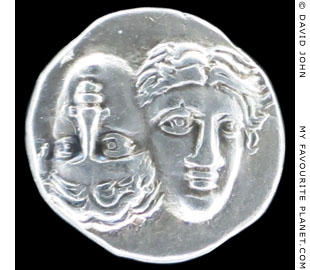
Heads of the Dioskouri, one upright and
the other inverted, on a silver drachm
from Istros (Ίστρος), a Greek colony
founded by Miletus in the 7th century BC
on the Black Sea coast (near modern
Istria, Romania). Circa 400 BC. [8]
Alpha Bank Numsimatic Collection,
Athens, Greece. |
| |
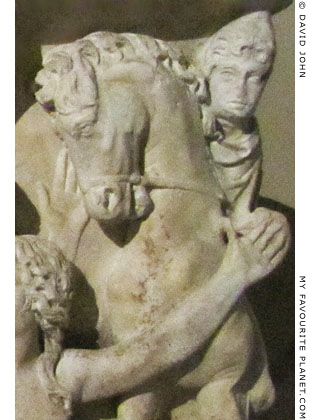
One of the Dioskouri on horseback,
on the corner of a marble relief on
the "Sarcophagus of Meleagros".
From Dyrrachium (Durres, Albania). Roman
period, first half of the 2nd century AD.
The Dioskouri twins sit on horseback on
either side of a relief frieze depicting the
myth of the Kalydonian hero Meleagros.
Istanbul Archaeological Museum.
Inv. No. 2100 T. Cat. Mendel 4. |
| |
| |
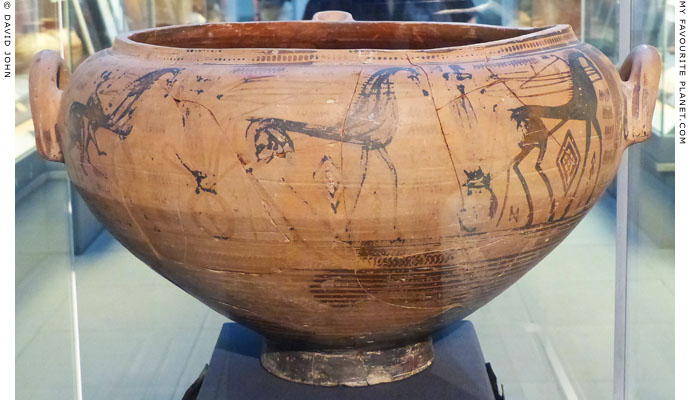
Two charioteers, perhaps the Dioskouroi, among horsemen
on an Athenian black-figure spouted krater (large bowl).
Geometric period, 735-720 BC (LGIIa). From Thebes.
British Museum. Inv. No. GR 1899.2-19.1.
|
The other side of the krater has a painting of a man grasping a woman by the wrist as he turns towards a ship with two rows of oarsmen. Thought to be an early representation of a myth, perhaps Theseus abducting Helen, Paris abducting Helen, the cause of the Trojan war, or Theseus fleeing King Minos of Crete with Ariadne. If the woman is Helen, then the two charioteers may be her brothers Kastor and Polydeukes.
See the other side of the krater in Homer part 2.
See also the Judgement of Paris in Greek, Etruscan and Roman art on the Hermes page. |
|
|
| |
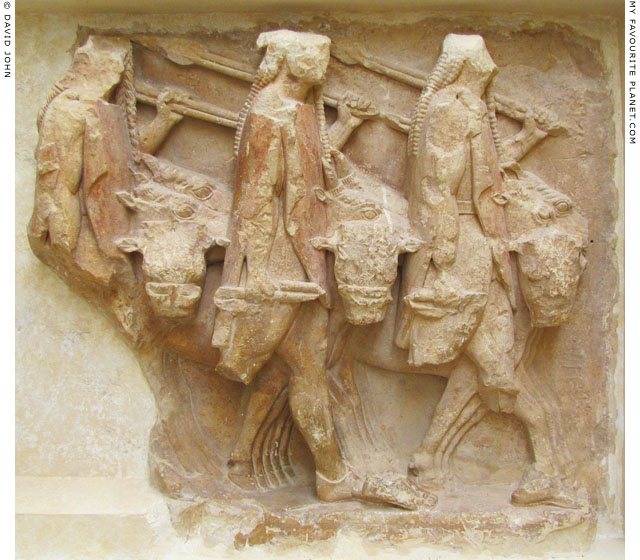
An Archaic high relief depicting a scene from the myth of the Dioskouroi and the Apharidae.
Part of a poros (limestone) metope of the Sikyonian "monopteros", an open
Doric colonnade at the Treasury of the Sikyonians, Delphi. Circa 560 BC.
Delphi Archaeological Museum, Greece. Inv. No. 1322.
|
The five surviving metopes from the Sikyonian monopteros were excavated at Delphi in 1894, in and around the Sikyonian Treasury. [9]
The Kastor and Polydeukes are shown walking to the right, followed by their Theban cousin Idas (Ἴδας, one of the the Apharidae twins), leading cattle as booty from their raid on Arcadia. Around 20 centimetres of the left side of the relief are missing, and it is thought that Idas' twin brother Lynkeus (Λυνκεύς) followed him. Painted inscriptions (two barely visible, on the right) showed the names of the figures.
All three men are shown in profile, at the same size, identical in dress and pose, and walk in step with the left leg in front. Each is naked apart from a chlamys (short cloak), fastened at the right shoulder and open at the side, a thick belt and sandals. Each carries two spears in the left hand, resting on the left shoulder, and another two horizontally in the right hand.
The oxen, shown smaller in scale, walk behind the men in rows of three, with three sets of legs and three heads. The heads are shown one above the other, with those in the rear rows at the top. The heads in the two rear rows are in profile, while those in the front rows are turned to face the viewer frontally. Strangely, the horns and ears of the oxen are shown in front of the men's cloaks. The composition as a whole has surprising depth and a dynamic rhythm, and must have been even more impressive when it was first sculpted and painted.
The brightly painted metopes had an unusual width-to-height ratio of 3:2.
Approximate dimensions: height 58 cm, length 87 cm, depth 16 cm, depth of relief 8 cm. |
|
|
| |
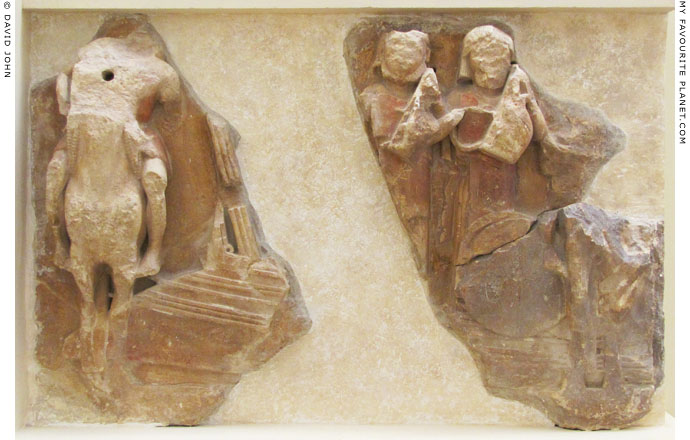
Fragments of an Archaic high relief depicting the prow of the Argo ship. On the left,
Polydeukes (name inscribed), one of the Dioskouroi, disembarks from the ship on horseback.
On the right stand Orpheus (name inscribed) and an unidentified musician, both holding lyres.
Part of a poros metope of the Sikyonian "monopteros", Delphi. Circa 560 BC.
It is thought that the image of the ship occupied three
metopes along the short side of the monopteros.
Delphi Archaeological Museum, Greece. |
| |
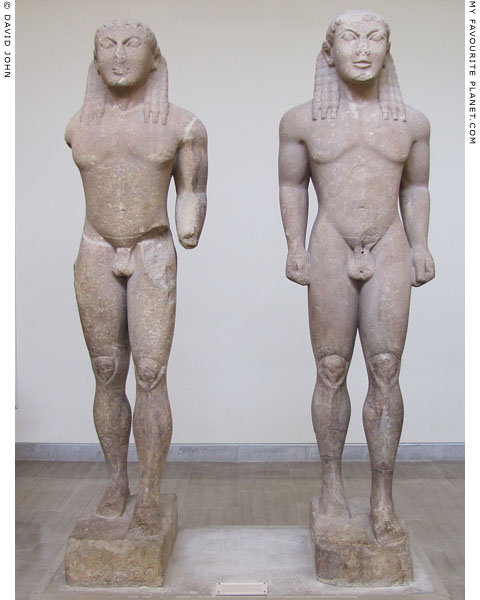
Twin marble kouroi statues in found in Delphi, originally identified as
the legendary or mythical brothers Kleobis (Κλέοβις) and Biton (Βίτων)
of Argos, but now thought by some scholars to depict the Dioskouroi.
Naxian marble. Circa 580 BC. Statue B (left): restored height 218 cm.
Statue A (right): height 216 cm; head height 30 cm;
base height 19 cm, width 38 cm, length 70 cm.
Delphi Archaeological Museum, Greece.
Statue B Inv. No. 1524, base 4672. Statue A Inv. No. 467, base 980.
|
Each of the two almost identical over life-size marble kouros statues depicts a muscular young man, standing naked apart from a pair of boots covering his feet and ankles. He steps forward with his left leg in a rigid pose typical of Archaic kouros statues, with each of his arms held at his sides, the fingers of his closed fist resting on the outside of the upper thigh. The head is slightly raised and his gaze is fixed straight ahead. His face is almost triangular, with the top of the head flattish, the forehead low.
Also a typical feature of Archaic statues is the carefully arranged hair, with a row of curls across the top of the forehead, and three thick plaits hanging from behind each ear, resting on the top of the chest. From the rear (photo, right) it is clear that there is a double band around the head at the level of the top of the forehead, and another holding in place the six plaits that hang down to between his shoulders.
It is probable that both figures were made by the same sculptor. As with other statues of the Archaic period, the growing interest in anatomical proportion and detail is evident, but its expression is still a long way from the perfection aspired to during the Classical period. Here muscle bulk is emphasized, while some details such as the edge of the rib cage above the abdomen and the top of the pubic hair are indicated by linear incisions. The modelling of knees on kouroi often seem over-emphasized, great oval lumps sunk between the flesh of upper and lower leg.
The style of the figures, particularly the heads, has been described as "sub-Daedalic", that is with characteristics of the end of the Daedalic style of Archaic Greek sculpture, prevalent around 650-600 BC. Typical are the carving of the hairstyle and facial features, deeply cut brows and eyes, the full lips and the large ears, set far back.
They were discovered during the massive excavations at Delphi, directed by Jean Théophile Homolle (1848-1925), director of the French Archaeological School at Athens (l’École française d’archéologie d’Athènes) 1890-1903.
The first statue, "Statue A" (right in the photo above), was found in May 1893 between the Athenian Treasury (after 490 BC), the Potidean Treasury (circa 500 BC) and the remains of a slightly smaller building of the early 6th century BC, which may have been a sanctuary of the Dioskouroi. Part of its inscribed rectangular base was found in November the same year.
The fragments of the second statue, "Statue B" (left), were discovered in May 1894. Parts of the second base were discovered in 1907, built into a wall of the Roman baths, outside the gate of the sanctuary, at the side of the road to Arachova.
Statue A is almost complete, and the soles of the feet on one of the bases allowed archaeologists to match them. Statue B is more fragmentary and has been restored; the lower legs and part of the base are modern additions. Both statues and bases are badly weathered, but the figures still have a remarkable intensity and presence, despite - or maybe because of - their exaggerated anatomies.
The base of Statue A (Base B) is inscribed with the artist's signature, the first letters of which are no longer legible:
[---]ΜΕΔΕΣ ΕΠΟΙΗΣΕΗ ΑΡΓΕΙΟΣ
([---]medes of Argos made me)
There have been varying readings and interpretations (see images below). The name has been reconstructed by some scholars as Polymedes of Argos (Πολυμεδες Αργειος), while others believe the sculptor was called Agamedes of Argos (Αγαμεδες Αργειος). Neither these are otherwise known as names of sculptors. Another inscribed line and the inscription on the base of Statue B (Base A) are illegible. The perhaps optimistic reading of letters on Base A as part of the name Biton remains a subject of scholarly debate. [10]
The identification of the statues as depictions of the Argive heroes Kleobis and Biton appears to rest on the signature by an Argive sculptor and the questionable reading of Biton's name on Base A, tied to a mention of statues of the brothers by the Greek historian Herodotus.
Kleobis and Biton were two legendary or mythical brothers from Argos whose story was mentioned by Herodotus. The strong young men fell asleep and died after pulling their mother's ox cart 45 stadia (around 8.3 km) to a festival at the temple of Hera in Argos (the Heraion, between Argos and Mycenae) [11], and Herodotus reported that "the Argives made and dedicated at Delphi statues of them as being the best of men". (Histories, Book 1, chapter 31)
It should be noted that Herodotus was relating a story he said was told by the Athenian statesman Solon to King Croesus of Lydia in the first half of the 6th century BC (it is doubted by many modern scholars that these two men ever met); he did not write that he had seen these statues himself or that they still existed in his day. Cicero wrote that the story of Kleobis and Biton was well-known, and it was referred to by a number of later ancient writers, including Polybius, Plutarch, Hyginus, Valerius Maximus, Lucian of Samosata, Pausanias and Diogenes Laertius. However, none of these authors mentioned statues in Delphi. [12]
The theory that the statues were among several dedications to the Dioskouri in Delphi has also yet to be proved, and also rests on conjectural readings of the inscriptions. As in the case of many ancient Greek sculptures, especially Archaic kouroi and korai, without recognizable attributes associated with particular deities and other figures, positive identification remains elusive.
Isotopic ratio analyses of marble samples from monuments in the sanctuary of Apollo at Delphi have shown that the statues are made of Naxian marble, from the Melanes or Apollonas quarry on Naxos, and not Parian marble as was previously thought.
See: Olga Palagia and Norman Herz, Investigation of marbles at Delphi. In: J. J. Hermann Jnr., N. Herz and R. Newman (editors), Asmosia 5: Ιnterdisciplinary studies οn ancient stone, pages 240-249. Archetype Publications Ltd., London, 2002. |
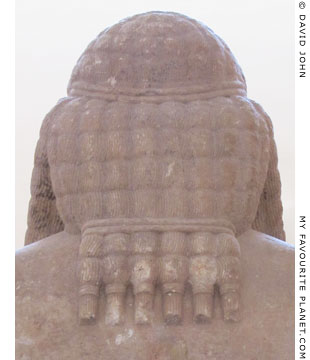
The back of the head of statue A.
Other kouros statues
on My Favourite Planet:
The colossal "Isches Kouros" from Samos,
"The Ram-Carrier of Thasos"
and smaller kouroi from Samos:
Samos photo gallery pages 4-5
A bronze kouros statuette in the Daedalic
style in the Delphi Archaeological Museum:
Daidalos page, MFP People
Various kouroi and korai statues:
Ancient Greek Sculptors A-D |
| |
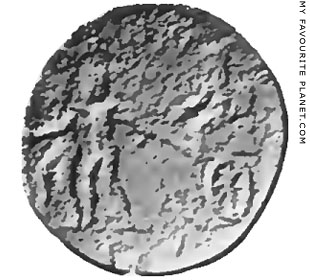
A Roman period copper coin of Argos with
a depiction of Kleobis and Biton pulling their
mother's cart in the form of a chariot.
Source: Friedrich Imhoof-Blumer and Percy
Gardner, A numismatic commentary on
Pausanias, Plate K, XXXIV (text on page 37).
Richard Clay and Sons, London and Bungay,
1887. At the Internet Archve. |
| |
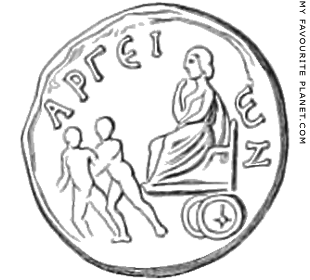
Kleobis und Biton pulling their mother's cart
on a Roman period copper coin of Argos.
Berlin State Museums (SMB).
Source of this drawing and that below:
Julius Friedlaender, Neue Erwerbungen des
K. Münzenkabinets. In: Archäologisches
Zeitung, 27. Jahrgang, pages 97-105,
Tafel 23, 9. Deutsches Archäologisches
Institut. Georg Reimer, Berlin, 1869.
At the Internet Archve. |
| |
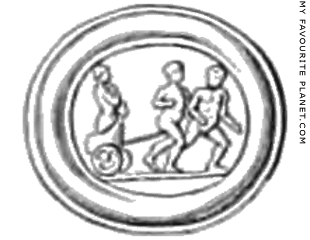
Kleobis and Biton pulling their mother's
cart on a gem of black glass paste.
100 BC - 100 AD.
Berlin State Museums (SMB).
Inv. No. FG 4372.
From the Stosch collection of gems,
purchased by Friedrich II of Prussia.
This gem was described in: Johann Joachim
Winckelmann, Description des pierres
gravées du feu Baron de Stosch,
Cat. no. IV,17, page 410. André Bonducci,
Florence, 1760. At the Internet Archve. |
| |
| |
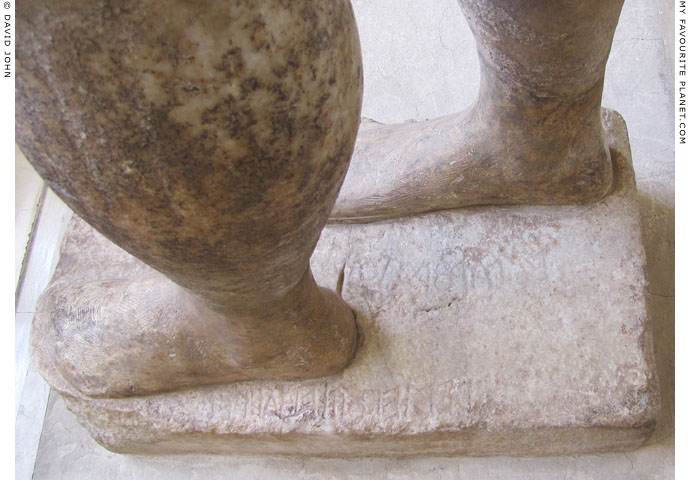
The inscription on the base of Statue A, with the sculptor's signature [---]ΜΕΔΕΣ ΕΠΟΙΗΣΕΗ ΑΡΓΕΙΟΣ
([---]medes of Argos made me), interpreted as either Polymedes of Argos (Πολυμεδες Αργειος)
or Agamedes of Argos (Αγαμεδες Αργειος). The various readings and attempted reconstructions
of the inscriptions on the bases include the ten variants of Syll.³ 5 (Syll.³ 5 - Syll.³ 5[10]).
See inscription Syll.³ 5 at The Packard Humanities Institute.
The other nine variants are on subsequent pages.
Wilhelm Dittenberger (editor) et al, Sylloge inscriptionum graecarum (SIG / Syll.),
3rd edition. 4 volumes. Leipzig, 1915-1924.
Each statue and its base were made from a single stone block.
"The figure, 2.16 metres in height, is of one piece with the base, which is rectangular in shape,
and follows the outside edges of the feet. Such a base, wrought out of the same block as the
statue, was called Σφέλας [sfelas], as is proved by the inscription on the colossal Apollo at Delos."
Frederik Poulson, Delphi, Chapter 6, The Delphian twins, page 90. Translated
by G. C. Richards. Gyldendal, London, 1920. At the Internet Archive. |
| |
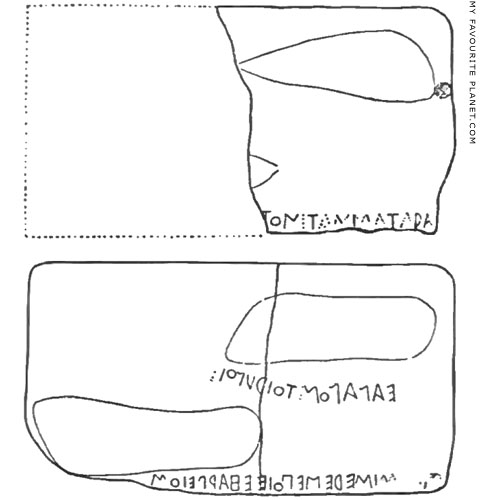
Drawing of the bases of the Delphian twins statues. The image of the base
of Statue B (top) has been turned around for easier reading of the inscription.
Source: Frederik Poulson, Delphi, Chapter 6, The Delphian twins, page 95.
Translated by G. C. Richards. Gyldendal, London, 1920. At the Internet Archive.
(Taken from: Anton von Premerstein, Kleobis und Biton. In: Jahreshefte
des Österreichischen Archäologischen Institutes in Wien, Band 13,
pages 41-49, Fig. 28. Alfred Hölder, Vienna, 1910. At the Internet Archive.) |
| |
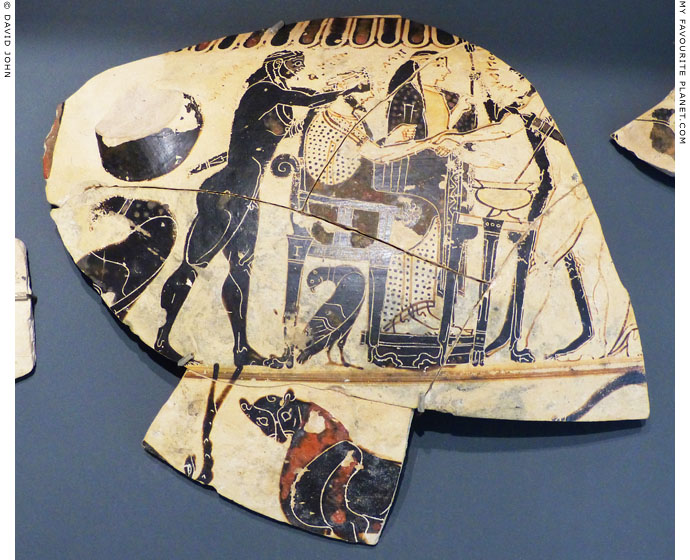
Jason, the leader of the Argonauts, places his hands over the eyes of the Thracian king Phineas
(Φινέας) to cure his blindness. Kastor and Polydeukes, right, assist. It has been suggested that
the female figure may be the earliest known representation of Queen Kleita (Κλειτα), wife of
Kyzikos, who Apollonias of Rhodes says played a role in the Argonauts' adventure. The names
of the figures are written near their heads.
Fragments of an inscribed black-figure Corinthian column krater, known as "the Argonauts
Krater", made in the workshop of the Cavalcade Painter, around 575-560 BC.
In the lower register is a standing lion. Another fragment shows Zetes and Kalais
(the Boreads, sons of Boreas, the North Wind) chasing the Harpies.
The fragments were discovered in the early 1970s by Stavros Andreadis on his family's
land, at what is now known to be the site of the Sanctuary of Artemis, Sani (ancient Sane),
Kassandra peninsula (ancient Pallene), Halkidiki. He donated them to the museum in 2005.
Thessaloniki Archaeological Museum. Inv. No. MΘ 23656.
(According to the museum catalogue, Inv. No. MΘ 1.)
See: Eurydice Kefalidou, The Argonauts Krater in the Archaeological Museum
of Thessaloniki. In: American Journal of Archaeology, Volume 112, No. 4, October
2008, pages 617-624. The University of Chicago Press. At ajaonline.org. |
| |
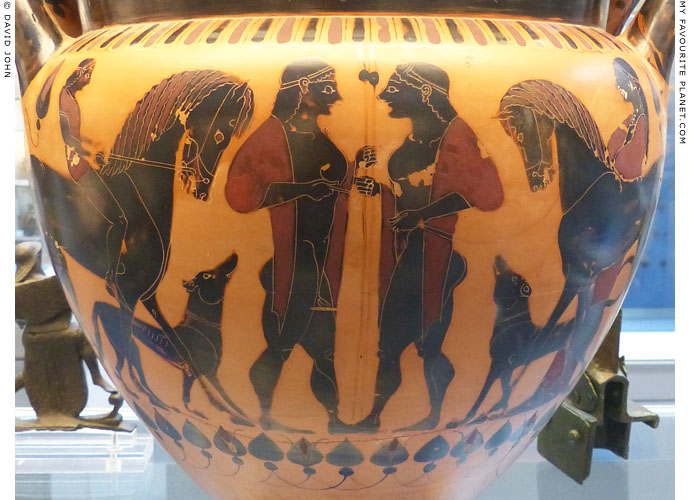
Detail of a black-figure column krater (bowl for mixing wine and water)
with two youths flanked by their horses and dogs.
From Vulci. Made in southern Italy, around 540 BC.
Attributed to the Inscriptions Painter (Chalcidian Group).
The figures have not been identified. Perhaps the Dioskouroi or two other heroes.
Pausanias noted that at the Anakeion, the sanctuary the Dioskouroi in Athens,
they "are represented as standing, while their sons are seated on horses."
Pausanias, Description of Greece, Book 1, chapter 18, section 1.
British Museum. GR 1843.11-3.38 (Vase B 15). Canino Collection. |
| |
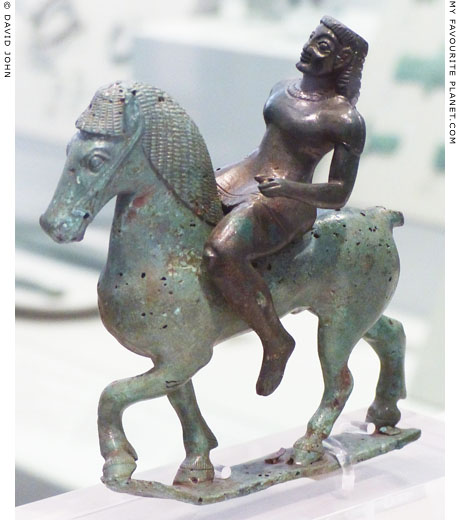
A bronze figurine of a horse and rider, perhaps one of the Dioskouroi.
Around 575-550 BC. From the Sanctuary of Zeus at Dodona, near Ionnina, northwest
Greece. Probably made by Corinthian metalworkers, perhaps living in the area.
The rider was found in 1875 during excavations at Dodona by Konstantinos Karapanos
(see note in Homer part 3). He looks masculine although he appears to have breasts.
He wears a short chiton (tunic), and is thought to have originally worn a petasos (broad-
brimmed hat), and to have held reins in his left hand and a spear in the right. The horse
was found in 1956 during excavations by Professor D. Evangelidis. A similar horse also
found at Dodona and now in the Louvre probably belongs to this rider, while the rider
of the horse above has not been found.
National Archaeological Museum, Athens. Inv. Nos. καρ. 27 and 16547.
Rider from the Konstantinos Karapanos Collection. |
| |
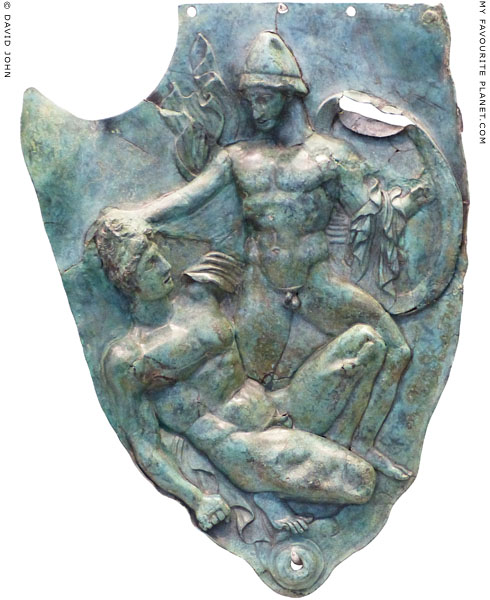
A bronze left cheekpiece of a helmet with a relief of two naked warriors fighting.
The warrior on the right wearing a pilos helmet (see Medusa part 6), a cloak
and carrying a round shield, appears to have defeated his opponent. Perhaps
Kastor fighting Lynkeus or Polydeukes fighting Idas [see note 4].
Late 5th - early 4th century BC. Found in 1875 in the Sanctuary of Zeus
at Dodona, near Ionnina, northwestern Greece, during excavations by
Konstantinos Karapanos (see Homer part 3).
National Archaeological Museum, Athens. Inv. No. καρ. 166.
From the Konstantinos Karapanos Collection. |
| |
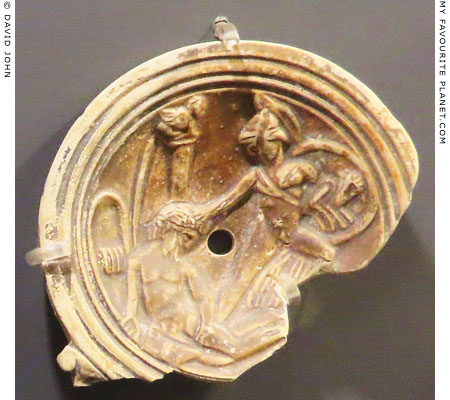
Part of a ceramic oil lamp with a disc relief of two naked warriors.
The scene is very similar to that on the bronze cheekpiece above.
In addition, are a shield and a weapon (?) behind the fallen warrior
on the left, as well as what appears to be a Sphinx on a column.
The museum labelling states that they are a hoplomachus and a
Samnite, two popular types of gladiator. But this is unconvincing,
particularly as gladiators did not fight naked, they were equipped
with armour and weapons according to their type. [13]
1st century BC. found in Rhodes. Thought to
have been made in an Italian workshop.
Rhodes Archaeological Museum.
Part of the extended exhibition "Ancient Rhodes - 2400 years"
in the Palace of the Grand Master, Rhodes, 2020-2022. |
| |
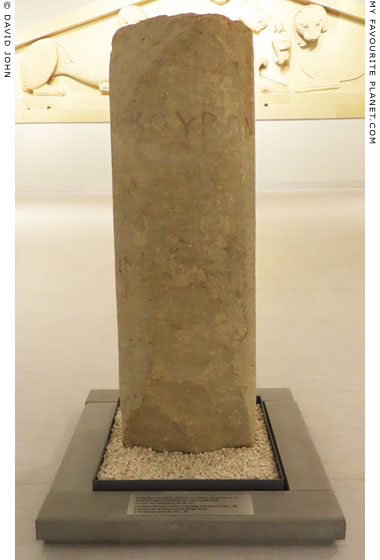
The inscribed limestone grave column of Lexeiatas, second half
of the 5th century BC, reused in the 4th century BC as a horos
(boundary stone) for a Dioskouroi sanctuary. Found in the 19th
century near the Monument of Menekrates in the Garitsa district,
south of the centre of Corfu town (ancient Korkyra). [14]. It
appears that the sanctuary itself has not yet been discovered.
The deceased's name ΛΕΞΕΙΑΤΑΣ (Λεξειάτας, Lexeiatas) is inscribed
retrograde (from right to left, with the letters reversed) and vertically
up the length of the column (see image below). Later ΔΙΟΣΚΟΥΡΩΝ
(Διοσκο̣ύρων, Dioskouron) was inscribed horizontally across the
column, near what is now the top. Height 142 cm, width 33 cm.
Corfu Archaeological Museum. Inscription IG IX 1² 4 883. |
| |

A drawing of the name ΛΕΞΕΙΑΤΑΣ (Λεξειάτας, Lexeiatas)
inscribed retrograde on the horos column in Corfu.
Source: Hermann Roehl, Inscriptiones graecae antiquissimae,
No. 345, page 81. Georg Reimer, Berlin, 1882. At the Internet Archive. |
| |
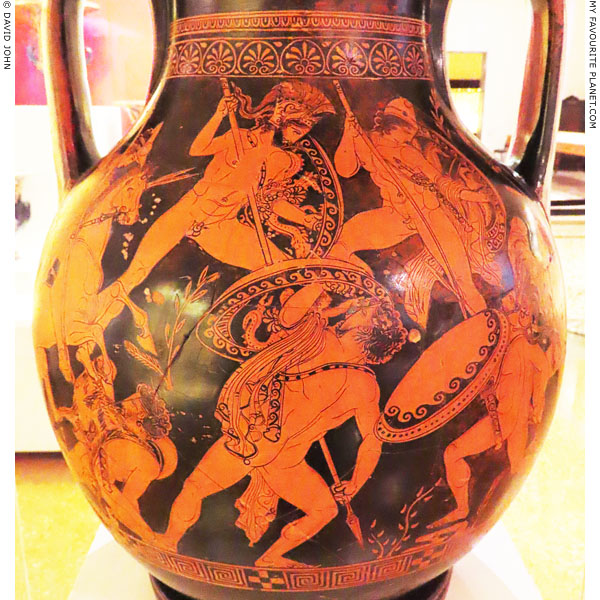
Ares, the Greek god of war, flanked by the Dioskouroi fighting in the Gigantomachy,
the epic battle between the Olympian gods and the Giants. Bearded Ares, wearing
a crested Attic helmet and carrying a spear with his right hand and a round shield
with the left, fights from above. To the right stands one of the Dioskouroi, wearing
a conical pilos helmet, and also armed with a spear and round shield. To the left,
the other heavenly twin rides a rearing horse. He wears a petasos (broad-brimmed
hat) and a chamlys (short cloak), which makes him the only one of the six figures
in the scene who is not nude. He carries a spear in his right hand and two more
in his left hand. The gods fight against three male Giants, similarly armed, who
fight with their back to the viewer.
On Side B: four youths, conversing, three standing, one seated. All a nude apart
from chlamydes (short cloaks) over their shoulders. Each holds two spears,
and has a petasos hanging behind his head. Plants suggest a rural setting.
An Attic red-figure pelike in the manner of the Pronomos Painter,
around 400 BC. From Tanagra, Boeotia, central Greece.
National Archaeological Museum, Athens. Vase collection. Inv. No. 1333. |
| |
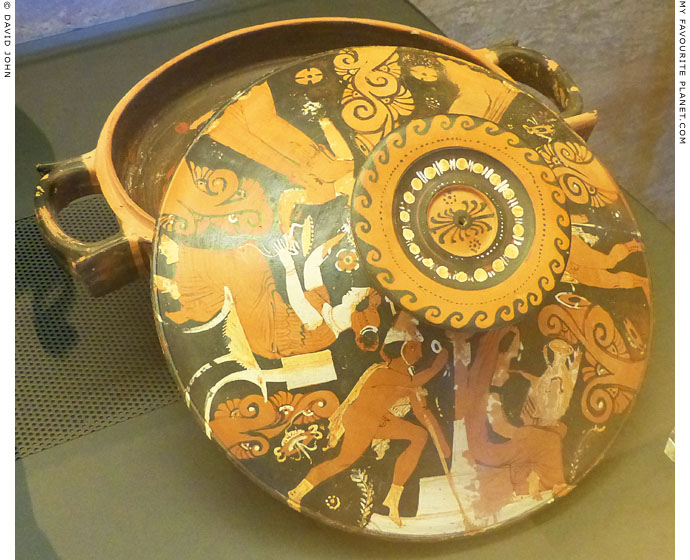
The lid of a Paestan red-figure lekanis [15] depicting a scene from the myth of
Orestes and Elektra: the Dioskouroi appear at the tomb of Agamemnon.
Attributed to the Floreale Painter, circa 330 BC. Excavated in 1954
at Tomb 5 in the necropolis at Laghetto, just northwest of Paestum.
National Archaeological Museum of Paestum, Campania, Italy.
|
In Greek mythology and literature, Agamemnon, king of Mycenae, was murdered on his return from the Trojan War by his wife Clytaemnestra and her lover Aigisthos. Orestes and Elektra, the children of Agamemnon and Clytaemnestra, avenged their father by killing their mother. The cycle of revenge and murder was mentioned in the poetry of Homer and Pindar and was the subject of plays by the Athenian tragedians Aeschylus, Euripides and Sophocles. At the end of Euripides' Electra (Ἠλέκτρα, written around 410-413 BC), the deified Dioskouroi appear and tell Orestes and Elektra that their mother's punishment was just, but they must nevertheless atone for their matricide and purge their souls.
At the front of this lekanis lid, as it appears in the photo above, Elektra sits mourning her father on his tomb. She is veiled and holds what appears to be a vase, perhaps Agamemnon's funerary urn. What appear to be two white teardrops can be seen in front of her face, but the paint is too worn to be certain. The Dioskouroi twins approach her from either side (see detail below; unfortunately the lekanis is displayed at the corner of a glass case, and its position and reflections made it it impossible to take a photo of both twins). Each is naked apart from a pilos (πῖλος) conical cap (see Medusa), chlamys (short cloak) and boots, and each holds a spear and another object which is offered to Elektra. It is uncertain what the twin on the left is holding, but his brother to the right of Elektra offers a golden wreath.
On other vases depicting this subject, two similar figures, dressed in the same way, have been identified as Orestes and Pylades, his cousin who, in some versions of the story, assisted in the killing of Clytaemnestra and Aigisthos.
See also:
Orestes killing Clytaemnestra on a bronze Etruscan mirror, in Homer part 3;
a "Melian" relief of Orestes and Elektra at the tomb of Agamemnon, in Homer part 3. |
|
|
| |
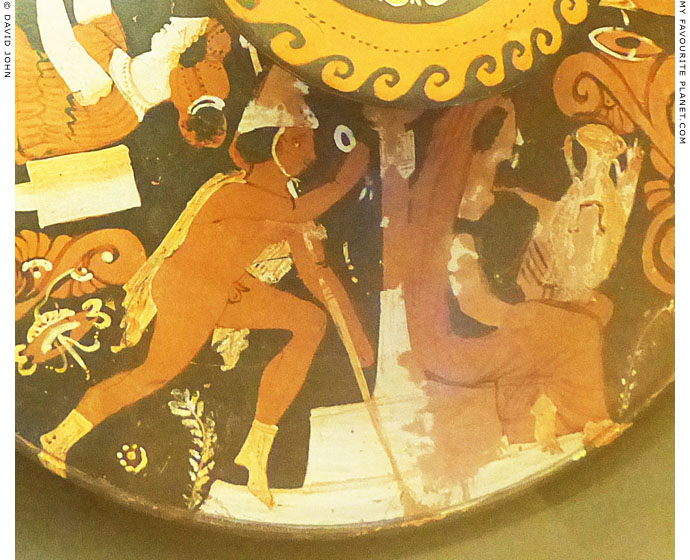
One of the Dioskouroi with Elektra on the lid of the Lekanis in Paestum. |
 |
|
|
| |
| |
 |
| |
 |
| |
 |
| |
 |
| |
 |
| |
 |
| |
George Alvanos
rooms in
Kavala's historic Panagia District
Anthemiou 35,
Kavala, Greece
kavalarooms.gr
|
| |
Olive Garden Restaurant
Kastellorizo,
Greece
+30 22460 49 109
kastellorizo.de
|
| |
Papoutsis
Travel Agency
Kastellorizo,
Greece
+30 22460 49 286
greeklodgings.gr
|
| |
| |
| |
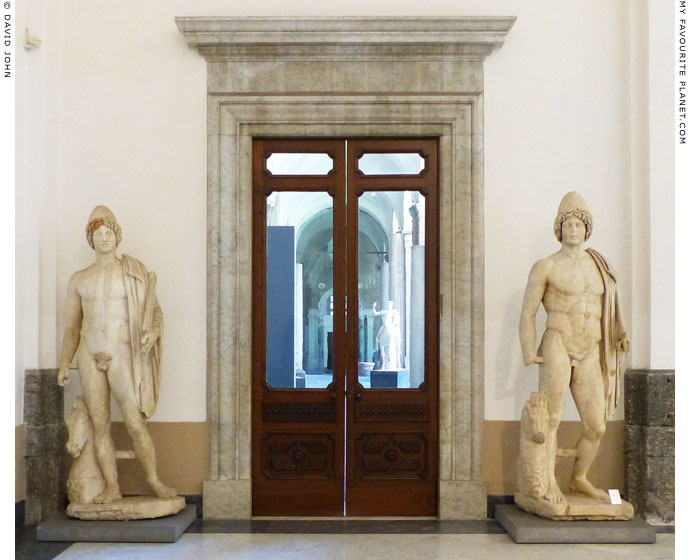
Colossal marble statues of Castor and Pollux, the Dioscuri.
2nd century AD, based on Greek models of the 5th century BC, particularly the
Doryphoros (spear carrier) of Polykleitos. Found at Baiae, in the Bay of Naples,
in the area of the baths, near the "Tempio di Venere" (Temple of Venus).
The twins are usually represented nude; each wears and pilos (πῖλος) conical cap
and a chlamys riding cloak. They are also nearly always shown with horses, here
reduced to a head and neck standing against the right leg of each figure and thus
doubling as a support for it. Both figures hold swords in their left hands.
National Archaeological Museum, Naples. Inv. Nos. 131209 and 230872. |
| |
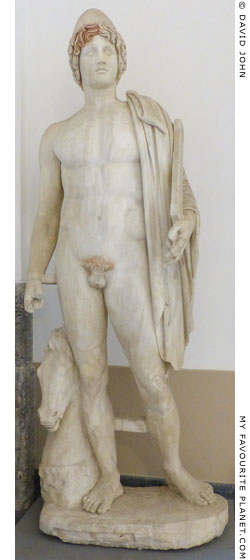 |
|
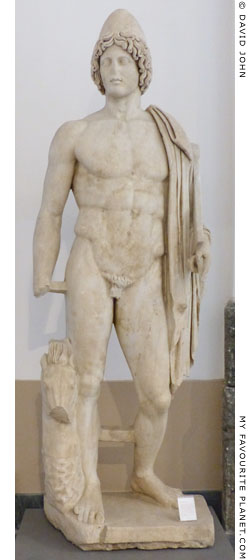 |
The statues of Castor and Pollux in the Naples Archaeological Museum.
There appears to be no indication of which twin is which. Traces of
dark red colour can be seen on the hair of the statue on the left. |
|
| |
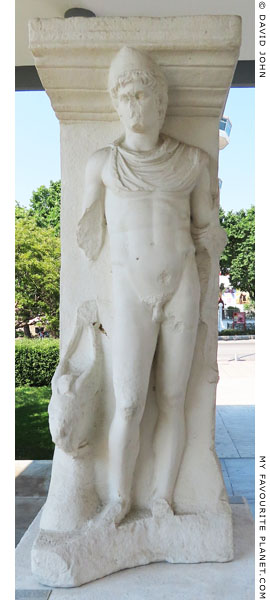 |
|
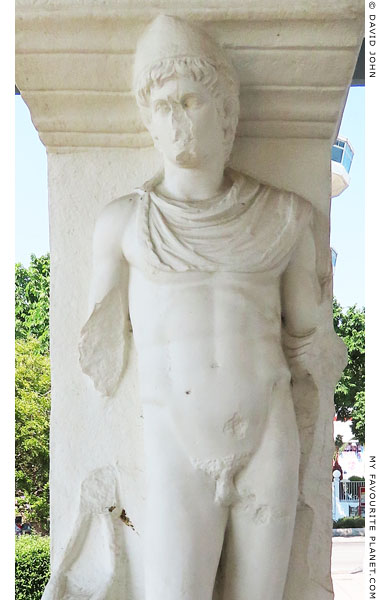 |
A replica of a marble high relief of one of the Dioskouroi on a pilaster from "Las Incantadas"
(the Enchanted Ones, see below) in Thessaloniki, Macedonia, Greece. The four pilasters
of the group have reliefs of Greek mythological figures on each side. On the other side
of this pilaster is a relief of Ariadne (see Dionysus).
Height 218 cm. The originals, of the late 2nd or early
3rd century AD, are now in the Louvre, Paris.
Like the Dioskouroi statues in Naples (above) and on the Roman Capitol (below), the
figure stands naked apart from a pilos cap and a cloak, in this case over his chest,
shoulders and part of his left arm. With his missing right hand he probabably held the
reins which rise from the head of the horse, which is shown only as a bust at his side.
Thessaloniki Archaeological Museum.
Original, Louvre, Paris. Inv. No. Ma 1392. |
|
| |

"Las Incantadas" standing in its original position in Thessaloniki in the mid 18th century.
A coloured print from a drawing by James Stuart, 1754. [16]
|
"Las Incantadas" (the Enchanted Ones) was the name given by Sephardic Jews of Thessaloniki during the period of Ottoman occupation to the 13 metre high remains of a two-storey marble colonnade that stood between Egnatia Street and the ancient Agora (today a park in the area where the statue of Eleftherios Venizelos now stands). It was known to the Greeks as "the Portico of the Idols" (η Στοά των Ειδώλων, i Stoa ton Eidolon), "The Enchantment" (Γοητειᾒα, Goeteia) or "the Magicians" (Οι Μαγεμένες, oi Magemenes), and to the Turks as "Suret-maleh" (angel figures).
A row of five columns with Corinthian capitals supported an inscribed epistyle on which stood four pilasters, each with a high relief of a Greek mythological figure on two sides. It is thought that originally the colonnade may have had more columns and at least one more pilaster, and that it may have been part of a baths complex.
During the Ottoman period the ruin of the colonnade became part of the courtyard of a Jewish merchant's house in the Rogos district, the city's only Jewish quarter above Egnatia Street. They were admired by a number of early European travellers who visited the city, notably James Stuart and Nicholas Revett [see note 16]. In 1864 the French palaeographer Emmanuel Miller, with the permission of the Ottoman authorities, removed the pilasters amid angry protests by local people, and sent them to the Louvre in Paris.
The order of the reliefs on the surviving pilasters, according to drawings by Stuart and Revett: along the north side of the colonnade (east-west), Nike, Aura, Dioskouros, Ganymede and the eagle (Zeus); along the south side (east-west) Maenad, Dionysus, Ariadne, Leda and the swan (Zeus).
The north side of each pilaster is usually referred to as Side A, and the south side as Side B. The pairs of reliefs on each pilaster, from east to west, and their respective Louvre inventory numbers:
Pilaster 1, Inv. No. Ma 1391
north side (A) Nike
south side (B) Maenad
Pilaster 2, Inv. No. Ma 1393
north side (A) Aura
south side (B) Dionysus
Pilaster 3, Inv. No. Ma 1392
north side (A) Dioskouros
south side (B) Ariadne
Pilaster 4, Inv. No. Ma 1394
north side (A) Ganymede and the eagle (Zeus)
south side (B) Leda and the swan (see photo below)
In 1997, during rescue excavations by archaeologists in Rogote Street (Οδός Ρογκότη) in the city centre, a fragment of another of the pilasters was discovered, with part of the head and a wing of a Nike relief (see photo, right). This is thought to be the only surviving part of the stoa now in Greece. Although the Roman period colonnade has generally been dated to the late 2nd or early 3rd century AD, according to the labelling of the Thessaloniki Archaeological Museum, the fragment was made around 225 AD.
As with the "Elgin Marbles", recent campaigns for the return of the pilasters to Greece have so far been unsuccessful, but did result in replicas made of Thassian marble being sent to Thessaloniki in September 2015. The copies cost 150,000 Euro, paid for by HELEXPO Thessaloniki International Fair (ΔΕΘ, TIF). Since September 2017 they have been exhibited in the open, roofed portico of the archaeological museum (see photo below). There are plans to move them to the small museum in the ancient Agora, which would be a good idea, as they are currently exposed to the weather and environmental pollution.
Update 2022: It appears that plans to move the pilaster replicas to the ancient Agora have been abandoned, and they are to remain in the porch of the Archaeological Museum for the forseeable future. |
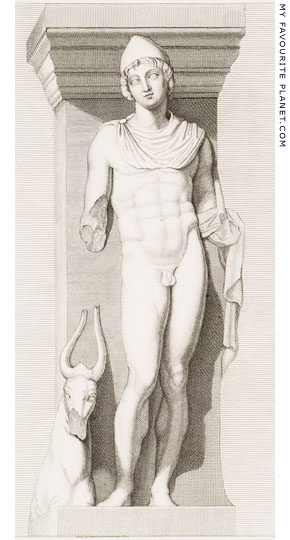
A drawing of the Dioskouros figure from
"Las Incantadas" by James Stuart and
Nicholas Revett, 1753-1754. |
| |
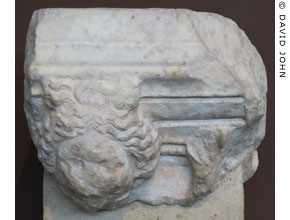
The fragment of the top of a pilaster
from Las Incantadas with part of a
relief of Nike. Found in 1997.
According to the museum labelling,
around 225 AD.
Thessaloniki Archaeological Museum. |
| |
| |
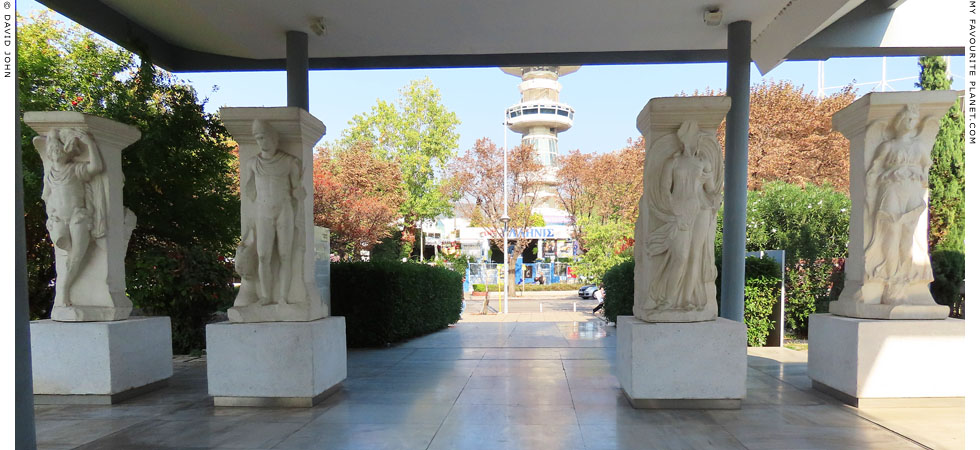
The four copies of the pilasters from "Las Incantadas", as displayed in
the portico of Thessaloniki Archaeological Museum. The view is hindered
by the columns. Left to right: Ganymede, Dioskouros, Aura, Nike |
| |
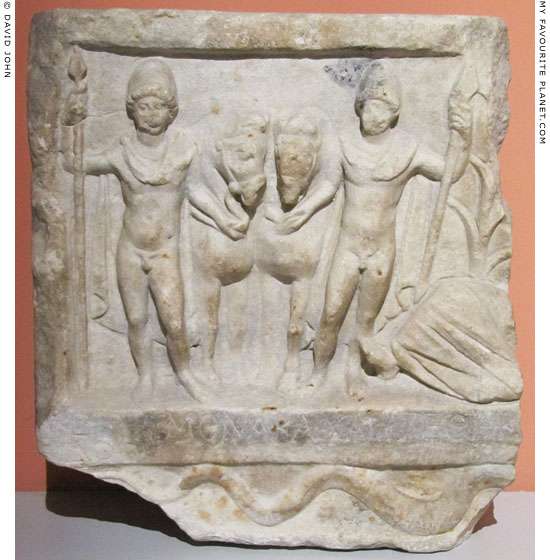
Fragment of an inscribed votive relief of Kastor and Polydeukes, the Dioskouroi,
and part of the reclining river god Strymon (Στρυμών), the personification of the
River Strymon, which flows though Amphipolis [17].
From Amphipolis, Macedonia, Greece. 2nd century AD. Roman Imperial period.
Amphipolis Archaeological Museum. Inv. No. Λ 673.
|
The mirrored figures of the Dioskouroi stand either side of their horses, facing frontally. Each is naked apart from a pilos (πῖλος) conical cap, chlamys (χλαμύς, short cloak), and holds a spear in the outer hand and the reins of his horse in the other. Only the front parts of the horses are shown. A tree or large plant and a foot and the lower part of the himation (cloak) of the reclining river god Strymon can be seen on the right edge of the broken stele. Below the inscription on the bottom of the frame of the relief is a serpent, a common feature of hero reliefs (see Pergamon gallery 2, page 10). The snake appears to be drinking or feeding from a spoon or leaf shaped object.
The remains of the inscription below the relief:
[C]ΤΡΥΜΟΝΑ ΚΑΙ ΧΑΡΙΤΕCΘΗΚ - - - -
ΔΟ
The quality of the workmanship is poor, and, as ever, it is tempting to believe that it is a copy, a faint echo, of a much finer work of an earlier age. No such original masterpiece has yet been discovered, but the iconography appears in several surviving ancient works, mostly from the Roman period, as can be seen in other photos on this page. |
|
| |
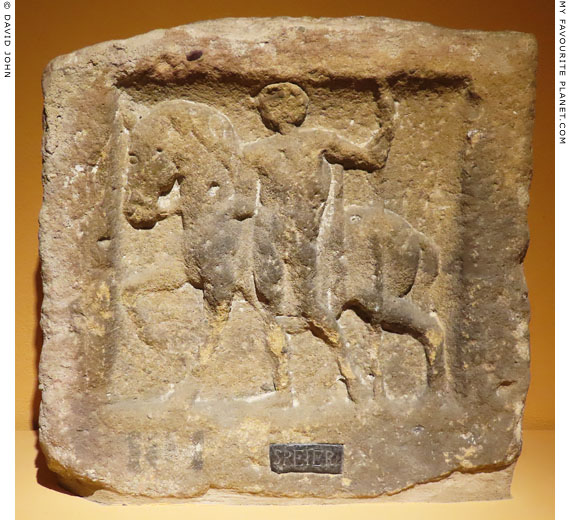
A Roman sandstone votive relief depicting one of the Dioscuri.
Roman. 2nd - 3rd century AD. Known since 1611 when it was recorded
among several ancient stone monuments in the Retscherhof, Speyer
(ancient Noviomagus / Civitas Nemetum, Germania Superior), Rheinland-Pfalz,
Germany. Height 42 cm, width 44 cm, present depth 17 cm.
Historisches Museum der Pfalz, Speyer, Germany.
The male figure, naked except from a cloak, stands in front of horse which faces left
and has one front leg raised. With his left hand he holds the horse's reins, and in
his left hand he holds an upright spear, the bottom of which rests on the ground.
The stone slab, the back of which is broken off, is thought to have been the base
for a column monument dedicated to Jupiter. It may have been one of a pair, each
showing one of the Dioscuri. On the left side is part of an inscription:
[---] Reg(inae?) / [---]orat- / [---]aug- / [---]ani- / [---]a
Inscription CIL 13, 11691.
See other Roman reliefs from Rheinland-Pfalz on the Hephaistos and Hermes pages. |
| |
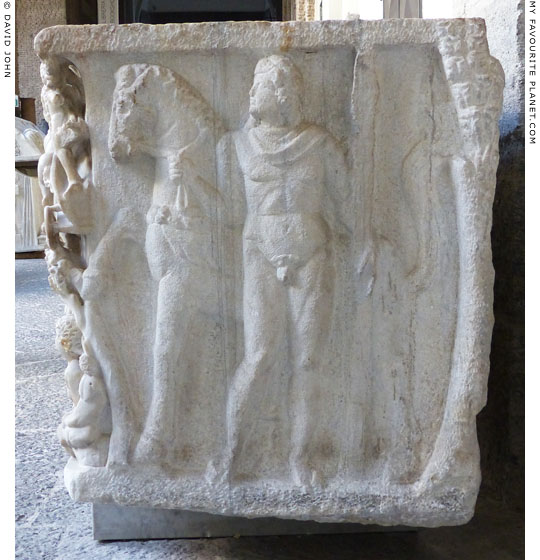
A relief of a youth with a horse, perhaps Castor
on the right side of a marble sarcophagus.
3rd century AD.
National Archaeological Museum, Naples. Inv. No. 6705.
|
The main relief on the highly polished front panel of the sarcophagus contains a complex scene representing the creation and destruction of man, which includes Prometheus among a number of gods and other mythological characters. The reliefs on the sides of the sarcophagus are more roughly carved. On the left side Atropos is shown determining the hour of death with a sun dial.
Since the theme of the reliefs is mortality, it has been suggested that the youth with a horse is Castor as the mortal twin of the Dioskouroi. He is shown bare-headed and naked, apart from a cloak over his shoulders. He stands frontally, with his head turned to the left. With his left hand he holds a spear and with his right hand he holds the reins of the horse that stands behind him, facing left with its right fore-hoof raised. |
|
| |

A bronze lamina (plaque) inscribed with a dedication in archaic Latin to the Dioscuri.
Castorei Podlouqueique qurois
To Castor and Pollux, youths
Late 6th century BC. Found at the Sanctuary of the Thirteen Altars,
Lavinium (today Pratica di Mare), an ancient port of Latium, around
30 km south of Rome and 22 km southeast of Ostia.
Height 5.0 - 5.3 cm, width 29.1 cm, thickness 0.10 - 0.15 cm.
Baths of Diocletian, National Museum of Rome. Inv. No. 135931.
Inscription CIL I(2): 2.4, 2883.
|
The lamina, known as "La Tabella Lanuvina", is broken in two pieces, which were discovered separately in August 1958, during excavations directed by Ferdinando Castagnoli (1917-1988) of the University of Rome. The five holes in the thin plaque, one at each corner and another in the centre, were for attaching it to another object, perhaps one of the thirteen altars.
The inscription, written in reverse letters and from right to left, is the earliest evidence of the cult of the Dioscuri in Latium. In this inscription their names and title appear to be direct transliterations into Latin from the Greek: Castorei (Κάστωρης, Kastores), Podlouquei (Πολυδεύκης, Polydeukes) and qurois (κούροις, kourois, youths), which has also been translated as "young knights" and "sons (of Zeus)". The twins were often referred to in Latin as the Castorei (Castores).
Ferdinando Castagnoli, Dedica arcaica lavinate a Castore e Polluce, in Studi e materiali di storia delle religioni, Volume 30, Fasc. 1, pages 109-117. Cesare Marzioli Editori, Rome, 1959. At Università degli Studi di Roma "La Sapienza". |
|
| |
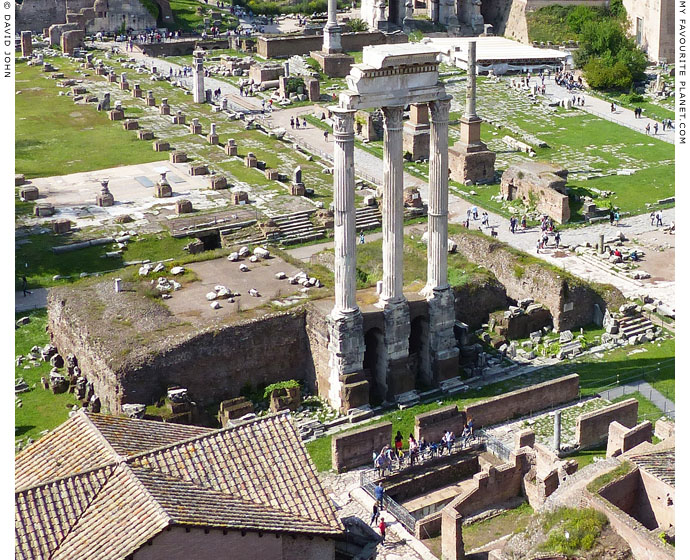
The three remaining Corinthian columns, part of the entablature and
the raised substructure of the Temple of the Dioscuri (Castores) on the
south side of the Sacra Via (right of the temple), in the Roman Forum.
|
Worship of Castor and Pollux, as the patrons of the knights, is thought to have been adopted by the Roman aristocratic party in the early 5th century BC. According to legend, two mysterious horsemen led the Romans to victory over the Etruscan Tarquins and Latins at the Battle of Lake Regillus around 499 BC. Shortly after, the pair, identified as the Dioscuri, appeared watering their horses at the Pool of Juturna, near the Temple of Vesta in the Forum, before announcing the Roman victory and then disappearing.
"And when the Romans conquered the Tarquins, who had taken the field against them with the Latins, two tall and beautiful men were seen at Rome a little while after, who brought direct tidings from the army. These were conjectured to be the Dioscuri.
The first man who met them in front of the spring in the forum, where they were cooling their horses, which were reeking with sweat, was amazed at their report of the victory. Then, we are told, they touched his beard with their hands, quietly smiling the while, and the hair of it was changed at once from black to red, a circumstance which gave credence to their story, and fixed upon the man the surname of Ahenobarbus, that is to say, Bronze-beard [Χαλκοπώγων, Chalcopogon]."
Plutarch, Aemilius Paulus, chapter 25, sections 1-2. At Perseus Digital Library.
The temple (also referred to as the Aedes Castoris) was probably built by the general and dictator Aulus Postumius Albus circa 484 BC [18]. The Roman knights held an annual parade in front of the temple on the 15th July. It was restored after 200 BC, and reconstructed in 117 BC by the consul Lucius Caecilius Metellus Dalmaticus following his victory over the Dalmatians. After being destroyed by fire in 14 or 9 BC, it was rebuilt during the reign of Emperor Augustus and inaugurated in 6 AD by Tiberius (later Augustus' successor). Although it was later restored several times, the existing remains are thought to be mostly from the Augustan period, apart from the podium which is that constructed by Metellus.
The peripteral temple, built on a podium approximately 32 x 49.5 metres and 7 metres tall, had 8 Corinthian columns, 12.5 metres tall, at either end, and eleven on each side. Like many of the ancient buildings of the Forum, it was built on a high substructure because of the marshy, uneven ground of the valley. The senate often met here and the building served as the office of the weights and measures inspectors. It had a tribune for orators and booths for bankers (or money changers).
Directly in front of the temple, the shrine of Juturna, the nymph of healing waters, was in the form of the Pool of Juturna (Lacus Juturnae) fed by a spring. Following the victory of the Roman consul and general Lucius Aemilius Paullus Macedonicus (circa 229-160 BC) over the Macedonian king Perseus at the First Battle of Pydna in 168 BC, the Dioscuri are said to have appeared again in the Forum. Aemilius Paullus built a fountain at the shrine, with a monumental basin in which were statues of the horses of the Dioscuri. The temple (or chapel) of Juturna was rebuilt during the reign of Trajan (98-117 AD). |
|
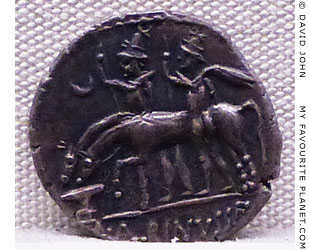
Roman denarius showing Castor and Pollux
with their horses drinking from a fountain.
Issued by C. Publicius Malleolus,
A. Postumius Albinus and
L. (Caecilius) Metellus, circa 96 BC.
Palazzo Massimo alle Terme,
National Museum of Rome. |
|
| |
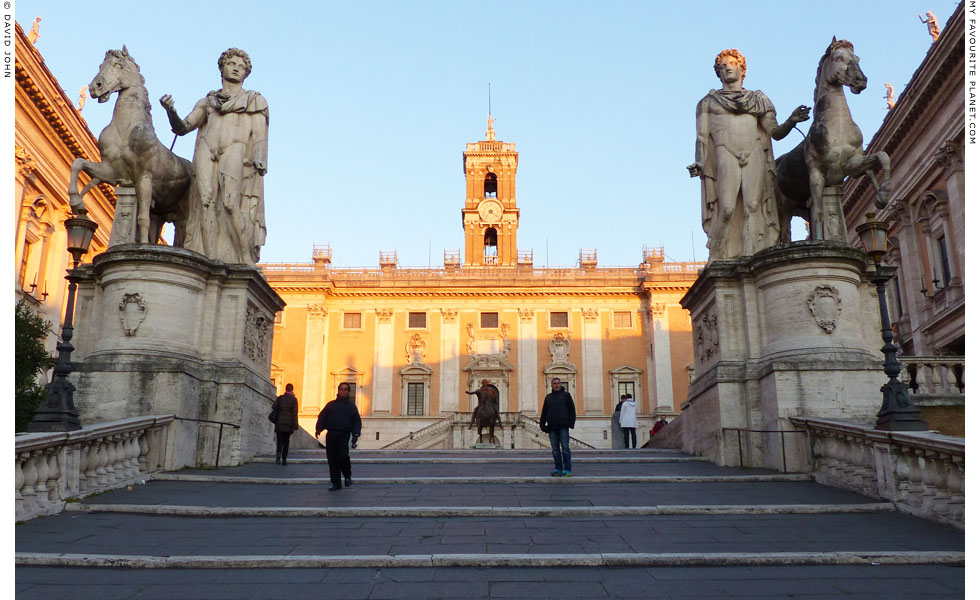
Colossal marble statues of Castor and Pollux standing with horses
on the balustrade flanking the top of the Cordonata, the stairway up
to the Piazza del Campidoglio, the square of the Capitoline Hill, Rome. |
| |
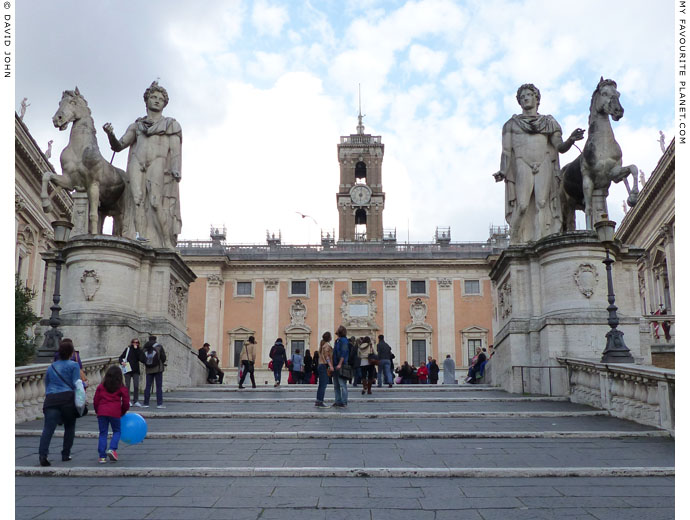
Colossal marble statues of Castor and Pollux with horses on the Piazza del Campidoglio, Capitoline Hill, Rome.
|
In the background is the Palazzo Senatorio, the 12th century senate house of the commune of Rome, now the offices of the city's mayor. It was restored by Michelangelo in 1546 and several times thereafter. The bell tower with the clock was added in 1582. The equestrian statue of Emperor Marcus Aurelius in the centre of the piazza has been replaced by a copy. The original is now in the Palazzo dei Conservatori of the Capitoline Museums, on the right of the piazza.
The balustrade, designed by Michelangelo, is decorated with several sculptures, previously intended to include two other colossal statues of Castor and Pollux which now stand on the Palazzo del Quirinale (see below).
The present statues were discovered either in the Ghetto or in the ruins of the Theatre of Pompey around 1561, during the time of Pope Pius IV (1559-1565). It is thought that they may have originally stood at the temple of the Dioscuri in the area of the Circus Flaminius (aedes Castori Polluci in Circo Flaminio), about which little is known. [19]
The account of the discovery of the statues by the contemporary Roman sculptor and antiquarian Flaminio Vacca (1538-1605):
"At the side of the Tiber, where at present they are making the Synagnogue of the Jews; in the time of Pius IV, there were found two giants holding two horses of statuary marble, which were transported to the Campidoglio, and collocated at the head of the stairs at the end of the Piazza, where at present they are to be found. And it was the opinion of some that said statues, were of Pompey, and of others, of Castor and Pollux from certain pumpkins like half eggs on their heads."
Flaminius Vacca, Memorie di varie antichità trovate in diversi luoghi della città di Roma (Memories of various antiquities discovered in diverse locations in the city of Rome), No. 59. Rome, 1594. Quoted in: Shakspere Wood, The Capitoline Museum of Sculpture, a catalogue, page 9. Printing office of the Propaganda Fide, Rome, 1872.
A more recent account by Wolfgang Helbig (1839-1915):
"The two Colossal Statues of the Dioscuri were discovered under Pius IV, apparently during the construction of the synagogue in the Ghetto *; and for a time lay, unrestored, behind the Balustrade. Some years later they were restored by the sculptor Valsoldo, and in 1583 they were erected on the Balustrade, at the head of La Cordonnata, or grand staircase ascending from the Piazza Aracoeli to the Capitol Square.
The figures are recognizable as the Dioscuri mainly by the pileus on their heads and by the horses which stand beside them. The horses are represented on a small scale in conformity with the principle of ancient art which emphasized the principal figures even at the cost of truth to nature. Each of the youths held his horse with one hand by the bridle, which was presumably added in bronze, while with his other he grasped a wooden or bronze spear. The execution is purely decorative in style and quite insignificant. In antiquity the two statues were probably placed as the ideal watchers of some monumental entrance."
* "Rom. Mittheilungen, VI, p. 33, According to the inscription on the back of the base of the figure to the right (as we look from the Piazza Aracoeli), both statues were found among the ruins of the Theatre of Pompey. The above statement, however, given on the authority of Flaminio Vacca (Berichte der philolog.-histor. Klasse der Sachs. Gesellschaft der Wissenschaften, 1881, p. 70, No. 52), seems more worthy of credence, as Vacca writes as an eye-witness of the discovery."
Wolfgang Helbig, Guide to the public collections of classical antiquities in Rome, Volume I, pages 287-288. Karl Baedeker, Leipzig, 1895.
The statue fragments were added to others found previously. Finally, Pope Pope Gregory XIII (1572-1585) decided to use the statues for Piazza del Campidoglio, and the fragments were restored and reassembled. Since the head of the statue now on the left had not been found, a new one was made using the head of the other statue as a model. In 1582 the finished statues were placed on pedestals similar to the one Michelangelo had designed by for the statue of Marcus Aurelius. |
|
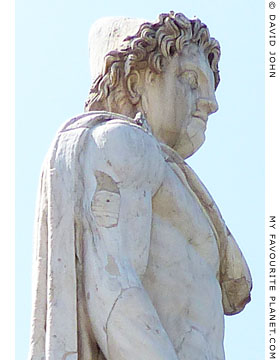
The Dioscuri statue on the right side
of the steps up to the Piazza del
Campidoglio. Both statues show
the twins wearing a pilos (πῖλος)
conical cap and a riding cloak. |
|
| |
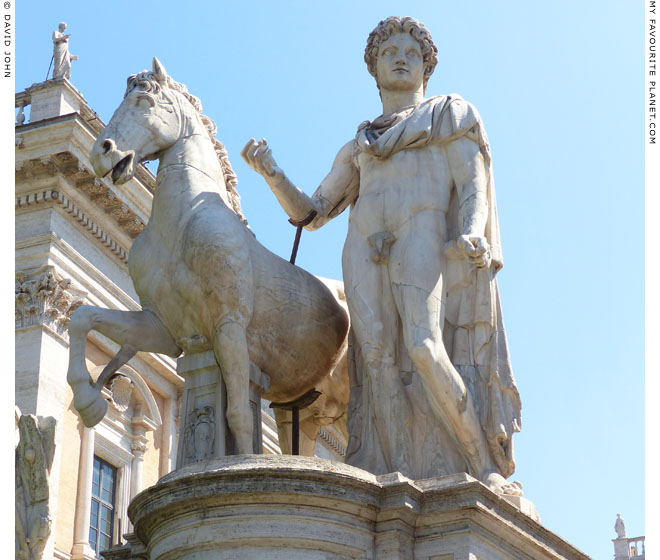
The Dioscuri statue on the left side as you climb the steps up
to the Piazza del Campidoglio, on the Capitoline Hill, Rome. |
| |
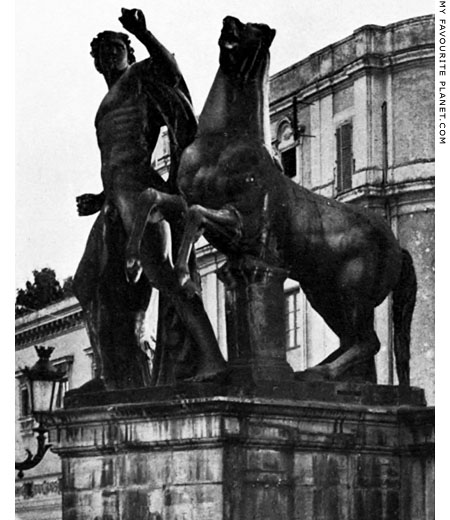 |
|
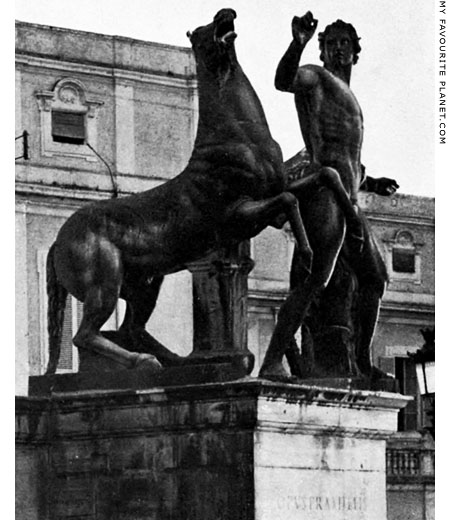 |
The statues of the Dioscuri on the Piazza del Quirinale, Quirinal Hill, Rome.
|
|
The two statues of Castor and Pollux with their horses, around 5.5 metres high, are thought to be Roman Imperial period copies of 5th century BC Greek originals. They stand on high pedestals in the middle of the square, flanking the Dioscuri Fountain and a 14.5 metre tall granite obelisk which previously stood in front of the Mausoleum of Augustus.
The statues, known as the horse tamers, had stood somewhere in the city since the fall of the Roman Empire, and during Medieval times were mentioned by authors and appeared in images of Rome. The false inscriptions on the pedestals, "Opus Phidiae" (work of Pheidias; statue in the left-hand photo) and "Opus Praxitelis" (work of Praxiteles; photo right), have been dated to circa 450 AD. They were discovered in the ruins of the early 4th century AD Baths of Constantine (Thermae Constantinianae) on the Quirinal Hill where they may have stood in antiquity. It has recently been suggested that they may have originally been set up at the entrance to the Temple to Serapis built by Emperor Caracalla (reigned 198-217 AD). This may also help explain why the heads of the two, much restored statues resemble portraits of Alexander the Great, since Caracalla developed an obsession for the Macedonian king (see Alexander the Great).
Pope Sixtus V (pontificate 1585-1590) commissioned Domenico Fontana to set the statues up on the square in 1588 and the hill became known as "Monte Cavallo" after them. The obelisk was added by Pope Pius VI in 1786, and in 1818 Pope Pius VII moved the fountain's dark grey granite basin there from in front of the church of S. Maria Liberatrice in the Forum Romanum, where it had been used as a cattle trough.
Photo source: Edmund von Mach (editor), University prints. Series A: Greek and Roman sculpture; 500 plates to accompany a handbook, plate A 129. University Prints, Boston, Mass., 1916. At the Internet Archive. |
|
| |
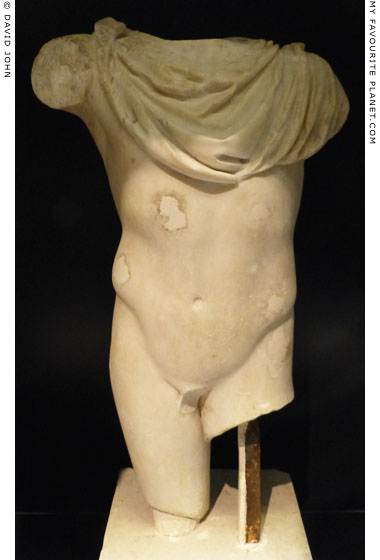
The torso of a marble statuette of a youth wearing a
cloak over his chest and shoulders. Perhaps one of the
Dioskouroi or Hermes (see similar statues of Hermes).
Probably 1st half of the 2nd century AD.
Height 60 cm, width 33 cm, depth 19.5 cm.
Skulpturensammlung, Albertinum, Dresden. Inv. No. Hm 249. |
| |
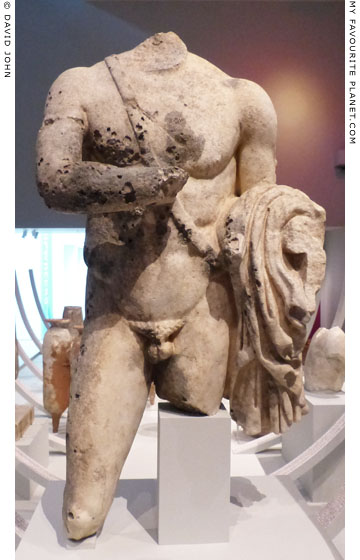
A marble statue of a warrior, perhaps one of the Dioskouroi.
Roman period, 200-1 BC. Found in the
sea off the coast Marsala, west Sicily.
The naked figure carries a small round shield and a military
cloak on his left arm and a sword belt across his chest.
Lilibeo-Baglio Anselmi Regional Archaeological Museum, Marsala. Inv. No. 4583. |
| |
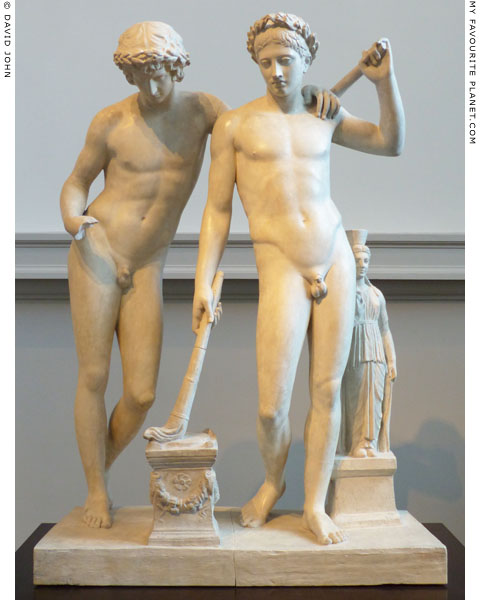
Plaster cast of the "San Ildefonso Group", marble staues of two youths,
perhaps the Dioscuri. The head of the figure on the left has been
replaced with a portrait of Antinous of the Apollo-Antinous type.
Augustan and Hadrianic periods, 1st century BC - 2nd century AD.
Height 160 cm, width 112 cm, depth 58 cm.
Abguss-Sammlung (Cast Collection), Semperbau, Dresden. Inv. No. ASN 2379.
Acquired in 1783 with the cast collection of Anton Rafael Mengs (1728-1779).
|
The original statue group, made of white Carrara marble, is in the Museo del Prado, Madrid (Inv. No. 28-E). Also known as the Ildefonso Group, it was named after San Ildefonso in Segovia, Spain, where it was kept at the palace of La Granja until 1839 when it was acquired by the Prado.
Probably found in the early 17th century in Rome, the earliest record of the sculpture is in 1623 when it was in the collection of Cardinal Ludovico Ludovisi at the Villa Ludovisi, Rome. After the cardinal's death it became the property of Cardinal Camillo Massimo, then of Queen Christine of Sweden, and in 1724 it was acquired by King Felipe V of Spain.
It is thought that the sculpture was made during the reign of Augustus (27 BC - 14 AD), and at some point the head of the youth on the left was replaced by a portrait of Antinous, Emperor Hadrian's deified favourite. This may have occurred either during Hadrian's reign (117-138 AD) or, more probably, when it was restored around 1623 by Ippolito Buzzi (1562-1634).
There is no other known statue group of this type, which is thought to be a Neo Attic creation inspired by works of 5th and 4th century BC Greek sculptors such as Polykleitos and Praxiteles. However, a late 1st century BC statuette in Athens is clearly a version of one of the right-hand figure of the group (see photo below). It has been suggested that the group may be a work by Pasiteles or his school.
Two idealized nude youths, wearing laurel wreaths, stand next to each other. The figure on the left leans on the other who holds two torches, with one of which he ignites a garlanded altar. The youths have been variously identified as Castor and Pollux, Orestes and Pylades, Hypnos and Thanatos (Sleep and Death), and Corydon and Alexis.
Behind the right-hand figure stands a small Archaistic female figure (see photo, below right) wearing a polos and a peplos, thought to be a statue of a goddess, perhaps Persephone or Artemis. Her right arm is bent, and in her raised right hand she holds a small round object, interpreted as an egg or a pomegranate, to her breast.
Although I have so far seen no other reference to this idea, I am reminded of figures of Helen of Troy wearing a polos or kalathos on reliefs depicting her standing between her brothers, the Dioskouroi (e.g. Sparta Archaeological Museum, Inv. Nos. 201, 202 and 203; see also reliefs of the Dioskouroi and Helen below). As mentioned above they were all said to have been born from eggs. Similar figures appear, for example, on the 2nd century AD "Leda sarcophagus" (see below), found in Kephissia, Attica. The relief on the left side of the sarcophagus depicts Leda and the swan (Zeus), and on the front Helen stands between the Dioskouroi. Each of the four figures on the corners, referred to as Caryatids or Helen-statues, wears a polos (or kalathos), peplos and hairstyle very similar to that of the San Ildefonso figure. They stand in the same pose, holding a small object between the forefinger and thumb of one hand which is pressed against her breast, while her other lowered hand clutches at the side of her garment.
See drawings and photos of the "Leda sarcophagus", as well as photos of two of the Spartan reliefs of the Dioskouroi and Helen:
Ellen E. Perry, Iconography and the dynamics of patronage: a sarcophagus from the family of Herodes Atticus. In: Hesperia, Volume 70, Issue 4 (October - December 2001), pages 461-492, particularly pages 474-475, figures 1 and 3 (Caryatids on the "Leda sarcophagus"), 6 and 7 (Spartan reliefs). American School of Classical Studies at Athens (ASCSA). At jstor.org.
A large number of casts and copies in various materials (bronze, marble, cast iron, porcelain) have been made of the San Ildefonso Group, and many are now in collections and museums.
The Dresden cast is well finished and polished, and is in remarkably good condition considering its history. It has been transported a number of times, and has survived the World War II bombings, confiscation by the Soviet army and the flooding of the River Elbe in 2002.
Until 2016 it was exhibited with the Sculpture Collection (Skulpturensammlung) in the Albertinum, Dresden (where the photo above was taken), but is presently (2018) displayed with other casts of ancient sculptures in a room in the Semperbau (or Semper-Galerie) of the Zwinger, which exhibits paintings of the Old Masters (Gemäldegalerie Alte Meister). The cast collection as well as the antiquities collection of the Dresden museums have been without a permanent home since 2002, although there are plans to house them in part of the Semperbau in the near future.
For further information about the Dresden Cast Collection
and Mengs, see the Niobe page. |
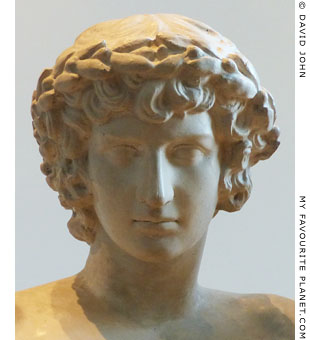
Head of Antinous of the Apollo-Antinous type
on the San Ildefonso Group cast in Dresden. |
| |

The small female figure of the
San Ildefonso Group in Dresden. |
| |
| |
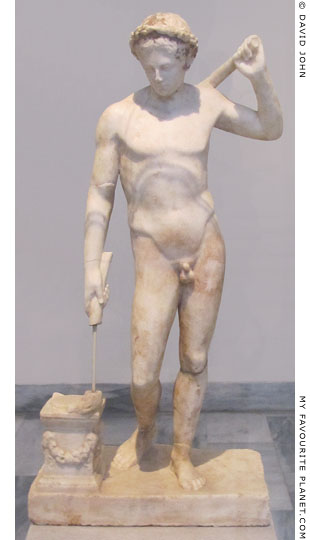
A marble statuette of a youth
of the Ildefonso type.
Around the end of the 1st century BC.
Provenance unknown.
"Probably Pentelic marble".
National Archaeological Museum,
Athens. Inv. No. 3631. |
|
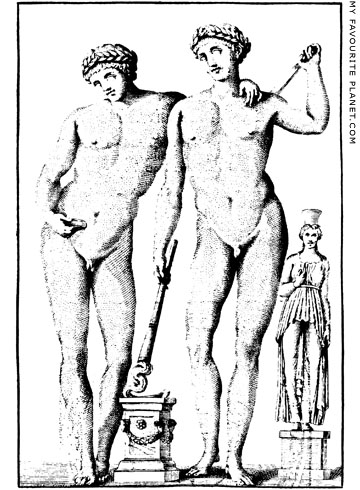
Anonymous engraving of the San Ildefonso Group,
published by Johann Winckelmann in 1767. The
print was produced after the group was sent to
Spain, and the original drawing may have depicted
a plaster cast, made around 1687-1706, which
stood in the French Academy in Rome.
Johann Joachim Winckelmann, Monumenti
antichi inediti spiegati ed illustrati da
Giovanni Winckelmann, Volume I (Unedited
antique monuments, described and illustrated
by Giovanni Winckelmann). An unnumbered plate
in the preface, between pages XIII and XIV.
Rome, 1767. At Heidelberg University Digital Library. |
|
| |
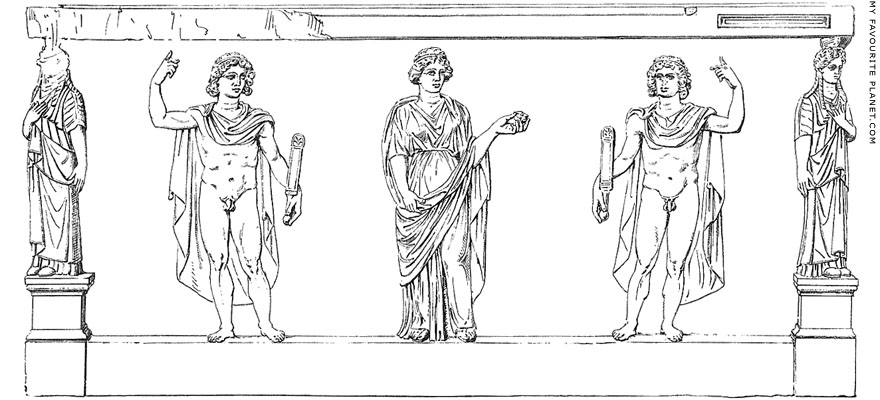
A relief of the Dioskouroi and their sister Helen of Troy on the front of the "Leda sarcophagus",
an Attic marble sarcophagus in Kifissia, northeast of Athens. Mid 2nd century AD.
|
Known as the "Leda sarcophagus", this is the largest of four sarcophagi in a marble tomb discovered in September 1866 near the church of Agia Paraskevi (used as a mosque, then a barracks, later demolished) on Platanos Square (Πλατεία Πλατάνου, Plateia Platanou), Kifissia, northeast of Athens. The sarcophagi are now displayed in situ in a small, purpose-built building. The area is thought to have been part of the estate of Herodes Atticus and Annia Regilla, and the sarcophagi the graves of four of their six children who died at a young age. This sarcophagus may have been made for Elpinike (Ἐλπινίκη), their second child and first daughter.
Sarcophagus height 112 cm; length 227 cm (front), 233 cm (back);
width 94 cm (left side), 89 cm (right side). [20]
The fragmentary gabled lid currently on the sarcophagus does not belong to it, and the original lid was probably a kline sculpture, depicting one or more figures lying on a kline (couch). Such sculptures usually depict the deceased (see an example of a kline sculpture on a Roman sarcophagus below, and on Etruscan cinerary urns in Homer part 2), and in this case may have been a portrait of Elpinike, and perhaps also her husband. A marble fragment of a reclining female figure (now missing) found in the tomb was probably part of the lid.
On the front is a relief of the Dioskouroi standing either side of their sister Helen of Troy. The twins are almost mirror images, arranged symmetrically, standing frontally with their heads turned towards Helen in the centre. In the lowered inner hand each holds an upturned, sheathed sword by its hilt, and the raised outer arm originally held a metal spear which was probably stolen by grave robbers. The figures stand in a contrapposto pose, with the weight resting on the outer leg and the other slightly bent. Each is naked apart from a fillet (headband) and a cloak which covers the chest and shoulders, and hangs to behind the mid calfs. On both figures the cloak is fastened at the right shoulder.
Helen faces frontally, with her head turned slightly to her left. She wears a fillet, a long, sleeved chiton girdled at the waist, and a himation (cloak), which rests on her shoulders, with the lower right side crossing in front of her lower torso and draped over her raised left forearm. In her left hand she holds a small object, perhaps an apple or a pomegranate.
The Classicistic relief on the left side of the sarcophagus depicts Zeus, disguised as a swan, attempting to copulate with a nude Leda (see image, above right), who appears to be trying to fend him off. His successful seduction or rape resulted in the birth of Helen and at least one of the Dioskouroi. Instead of webbed feet the huge swan has the talons of a bird of prey, presumably an eagle, a symbol of Zeus. This work has been compared to reliefs of Leda and the swan from Brauron (Athens National Museum, Inv. No. 1499) and Argos (British Museum, Inv. No. 1973,0302.1, Sculpture 2199).
On the right side is a relief of winged infant Eros stringing his bow, perhaps as a prelude to the erotic scene on the other side. The figure is of a type known from a number of other sculptures. The relief on the back shows a Nereid riding on the tail of a Triton.
At each of the four corners of the sarcophagus a "Caryatid", perhaps representing a statue of Helen (see above), stands on a statue base. The top of each figure's polos touches and appears to be supporting the upper moulding of the casket, in the way that Caryatid statues were used as columns to support the roofs of buildings (see, for example, the Caryatids of the Erechtheion on the Athens Acropolis). In this case, the moulding represents the frame of the kline, and the Caryatids its legs. Each figure wears a polos (or kalathos) and peplos, and holds a small object between the forefinger and thumb of one hand which is pressed against her breast. Her other lowered hand holds the side of her garment. The Caryatids at the edges of the front of the sarcophagus are mirrored for the sake of symmetry, so that the figure on the left holds the object in her right hand, and that on the right has it in her left hand. On the back the relative positions are reversed.
As is often the case with such reliefs, those on the front and two sides have been considered to be copied from or influenced by statues. The composition and frame of the Triton relief suggest that it may have been modelled on a two-dimensional work, perhaps a relief, painting or mosaic.
See: Ellen E. Perry, Iconography and the dynamics of patronage: a sarcophagus from the family of Herodes Atticus. In: Hesperia, Volume 70, Issue 4 (October - December 2001), pages 461-492. American School of Classical Studies at Athens (ASCSA). At jstor.org.
Drawings of the sarcophagus made in Autumn 1886 by the Swiss artist and archaeological draughtsman Émile Gilliéron (1851-1924).
Source of drawings: Carl Robert (1850-1922), Die antiken Sarkophag-reliefs Band II, Mythologische Cyklen, No. 9, pages 9-10 and Tafel III, 9 and 9a. G. Grot'esche Verlagsbuchhandlung, Berlin, 1890. At Heidelberg University Digital Library.
The discovery of the tomb was first published in: Otto Benndorf, Römishes Grab in Kephisia. In: E. Hübner (editor), Archäologisher Zeitung 26, pages 35-40 (Tafel 5, 2). Georg Reimer, Berlin, 1868. At the Internet Archive. |
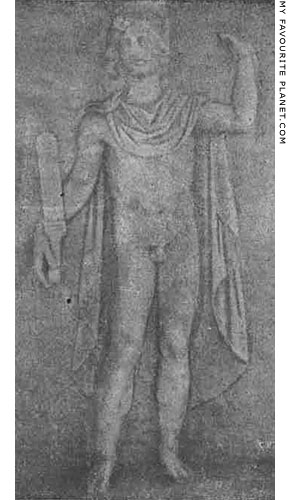
An early photo of the right-hand Dioskouros on
the front of the "Leda sarcophagus" in Kifissia.
Source: Carlo Anti, Lykios, Fig. 8, page 32. In:
Bullettino della Commissione Archeologica
Comunale di Roma, Anno 47 (1919), pages
55-138. P. Maglione & C. Strini, Rome, 1921.
At Heidelberg University Digital Library. |
| |
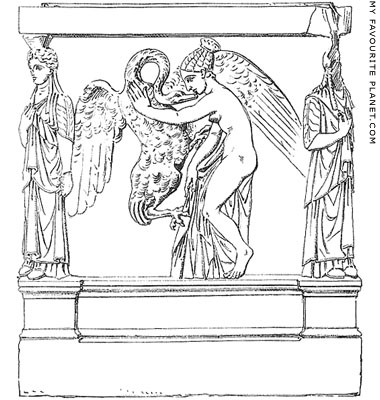
Leda and the Swan on the left side of
the "Leda sarcophagus" in Kifissia. |
| |
| |
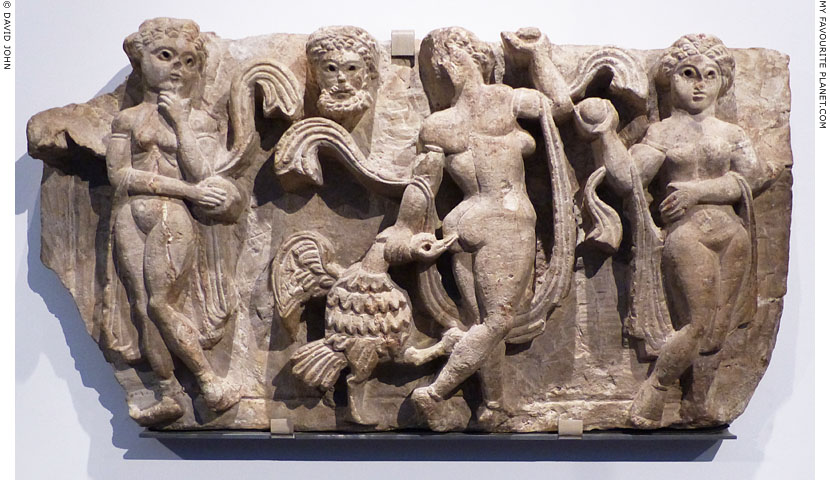
The myth of Leda and the Swan on a limestone block from a frieze sculpted in high relief.
In the centre, Leda is seen from behind, nude, holding the Swan (Zeus) by the throat
with her left hand. The bird has its left foot on her right calf. to the left of Leda is the
head of a bearded male, perhaps Zeus (or Tyndareos?). To either side of her stands
a Nymph holding an egg, symolizing the conception of Leda's children, Clytaemnestra,
Helen, Kastor and Pollux. In early Christian Egypt this pagan myth remained a popular
motif for memorials to fertile married women.
Around 400-500 AD, Late Roman period. Probably from a woman's tomb at Oxyrhynchus, Egypt.
Ashmolean Museum, Oxford. Inv. No. AN1970.403. |
| |
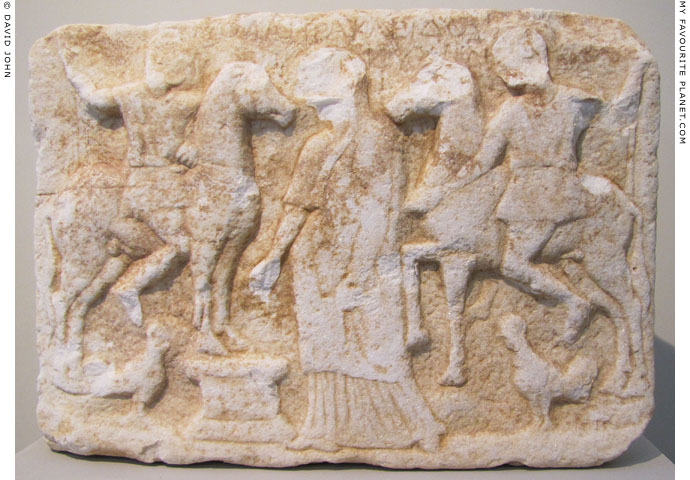
Inscribed votive relief of Helen (of Troy) standing between the two mounted Dioskouroi.
Found in 1928 near a Byzantine chapel in the area of the necropolis of Thasos, Macedonia,
Greece. According to the inscription, roughly incised above the heads of the three figures,
the relief was dedicated by Pola, daughter of Herakleides.
Πόλα Ἡρακλίδου εύχήν
Late Hellenistic period. Height 30 cm, width 45 cm.
Thasos Archaeological Museum. Inv. No. 22.
|
The relief shows the Dioskouroi on horseback, each with the outer arm (which may have held a spear) raised, and facing a woman in the centre, standing at an altar. It is thought that she may be their sister Helen. Two cockerels stand on either side of her, below each of the horses.
The popularity of the Dioskouroi on the northen Aegean island of Thasos (Θάσος) may be due to the influence of Paros, which colonized the island around 680 BC (see History of Kavala). The annual Dioskouria festival included public feasts (symposia). The main Dioskouroi sanctuary of Thasos is thought to have been at a location known as Patargia (also referred to the "Plain of Patargia"), the area of the necropolis, outside the southern city walls, where this and other reliefs depicting the twins with a woman, perhaps Helen, have been discovered (e.g. Thasos Archaeological Museum, Inv. Nos. 145 and 1286). At Alyki (Αλυκή), on the southeast coast of the island, a sanctuary built between the 6th and 5th centuries BC may also have been dedicated to the twins. Graffiti inscriptions found there are prayers to the Dioskouroi for "salvation from the dangers of the sea" and "safe voyages".
Similar reliefs depicting the Dioskouroi with a female figure, probably Helen, have been found at a number of other locations, including Sparta, Amphipolis (see below) and Telmessos. They may have been worshipped at these places as a triad. Helen was included in the worship of the Dioskouroi at many of their sanctuaries, particularly at Sparta (perhaps from the 2nd or 1st century BC), and it has been suggested that in some places she may have become syncretized (amalgamated) with a local deity.
Pausanias mentioned an ancient image of Helen between the Dioskouroi among several mythological scenes on the "chest of Kypselos" (or "chest of Cypselus"), a richly decorated Archaic cedar-wood chest dedicated by the Corinthians, in the Temple of Hera, Olympia (see the description of the chest in Homer part 2).
"On the chest are also the Dioscuri, one of them a beardless youth, and between them is Helen."
Pausanias, Description of Greece, Book 5, chapter 19, section 2. At Perseus Digital Library. |
|
| |
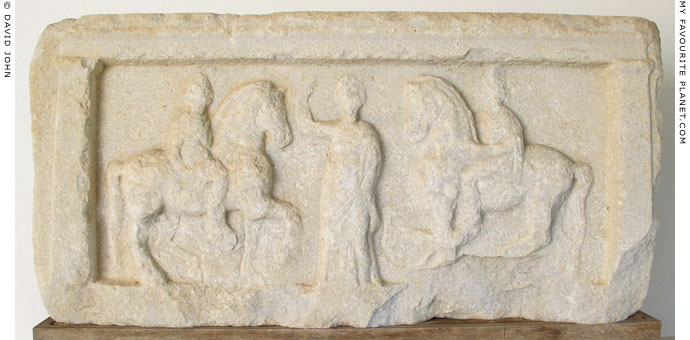
An unlabelled limestone relief outside Amphipolis Archaeological Museum depicting
two horsemen, each wearing a pilos, cloak and short chiton (χιτών, tunic), either
side of a woman with her right arm raised. Perhaps the Dioskouroi and Helen.
Amphipolis (Ἀμφίπολις) in Thrace was colonized by Athens in 437 BC, but captured by the Spartan
general Brasidas in 424 BC, during the Peloponnesian War (see History of Stageira part 5).
The Spartan influence on the culture of the city may explain the iconography of the relief.
Amphipolis Archaeological Museum. Inv. No. Λ834.
See another relief of the Dioskouroi from Amphipolis below. |
| |
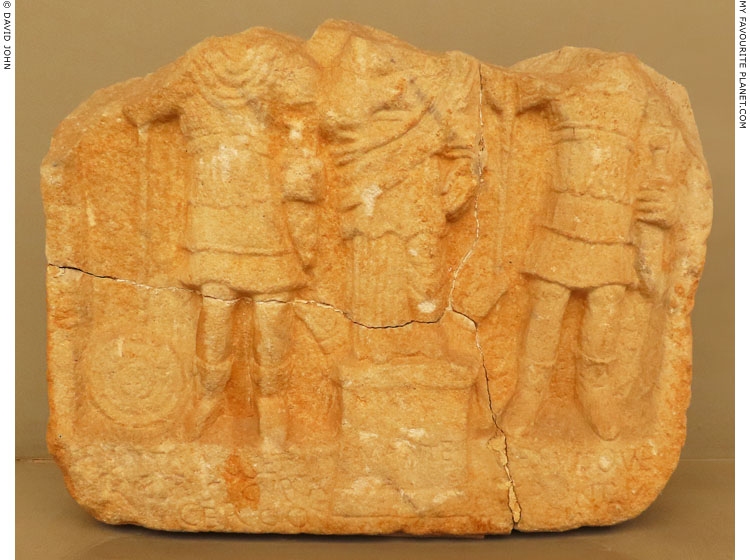
Bottom part of a fragmentary inscribed votive relief with a depiction of the Dioskouroi as
Roman infantry men. They stand facing frontally, either side of a female figure, who stands
on a plinth or altar on the front of which the name MANTA is inscribed. Manta was the local
variation of Helen, the sister of the twins, who was worshipped together with them. The top
of the relief and the head of the figures are now missing. The Latin inscription at the bottom
of the relief is now illegible, but the words Dioscuris and Manta can still be discerned.
Found in Drama (Δράμα), East Macedonia, Greece.
2nd - 3rd century AD, Roman Imperial period.
Drama Archaeological Museum. Inv. No. Λ 97. |
| |
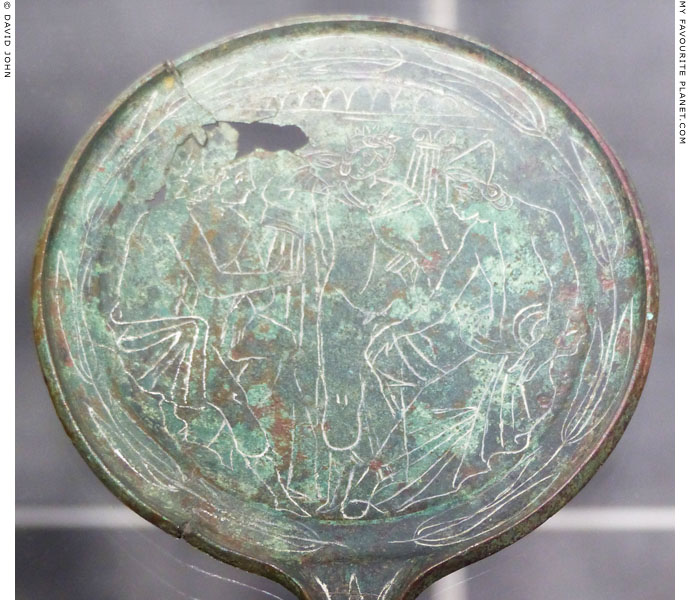
Detail of an Etruscan bronze mirror with incised decoration depicting three figures,
interpreted as three of the Cabeiri (Κάβειροι, Kabeiroi), also known as "the Great
Gods" (Μεγάλοι Θεοί, Megali Theoi). The Dioskouroi were known to the Etruscans
as Kastur and Pultuce, and together as the Tinas Cliniiaras (Sons of Tinia, the
Etruscan equivalent of Zeus). They sit either side of an unidentified deity in a
temple, indicated by an Ionic column and part of an architrave.
Mid 3rd - early 2nd century BC. Diameter 13 cm, length (including handle) 27cm.
Civic Archaeological Museum, Milan. Inv. No. A 0.9.1002.
From the Ancona Collection, then the Seletti Collection. |
| |
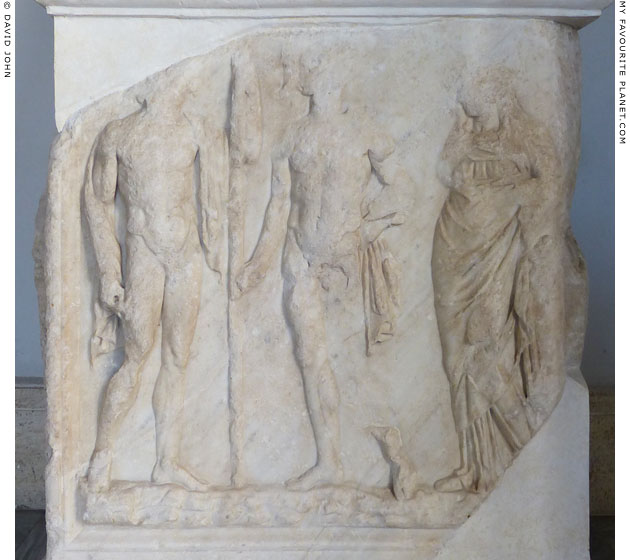
Fragmentary marble statue base with a relief of the Dioscuri with their sister Helen of Troy.
30-20 BC, Roman period copy of a 4th century BC original.
The side of the base to the left has part of a relief of Helen standing
in front of their mother Leda (see photo below). The Hellenistic statue
of Juno/Hera known as the "Juno Cesi" now stands on the restored base.
Sala del Galata (Hall of the Gaul), Palazzo Nuovo,
Capitoline Museums, Rome. Inv. No. MC 1961. |
| |
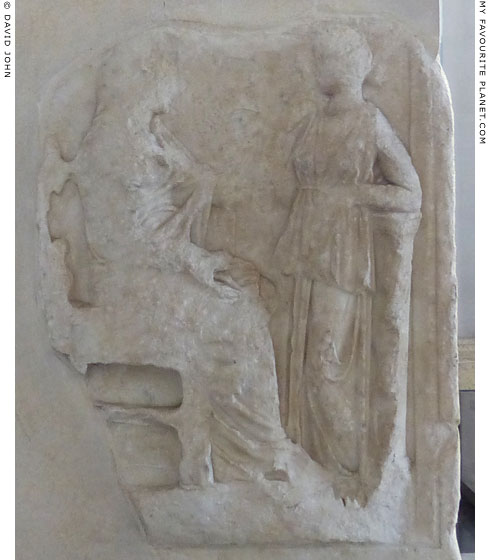
Fragmentary relief of enthroned Leda with Helen of Troy
on the left side of the statue base above. |
| |
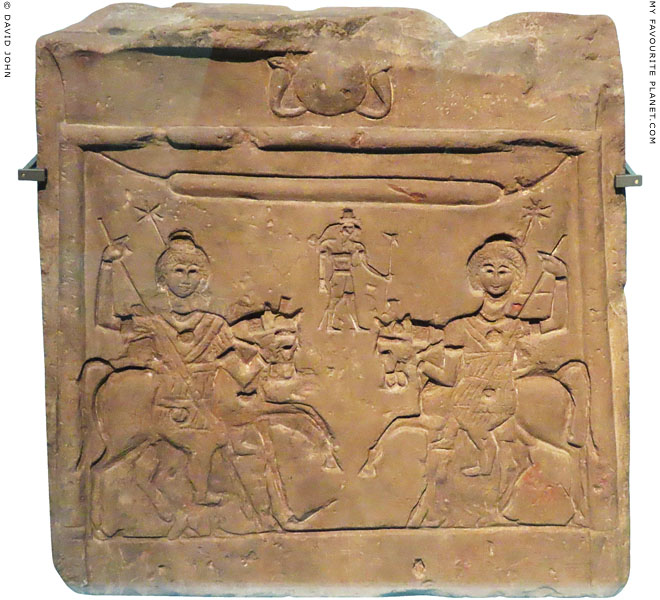
An Egyptian sandstone votive stele with a relief of the Dioscuri on horseback.
The two figures are mirror images, each wearing armour, holding a spear in the outer
hand and with a star above his head. Between them is the full figure of the Egyptian
falcon-headed god Horus (the moon god Khonsu has also been suggested). At the centre
above the frame of the main relief is the Egyptian sun-disk symbol with two serpents.
Late Hellenistic or early Roman Imperial period. Place of origin unknown. Purchased in Egypt
in winter 1900-1901 by the Italian Egyptologist Ernesto Schiaparelli (1856-1928), director
of the Museo Egizio di Torino, 1894-1901. Height 53 cm, maximum width 52 cm, depth 9 cm.
Museo Egizio, Turin. Inv. No. S. 01321. [21] |
| |
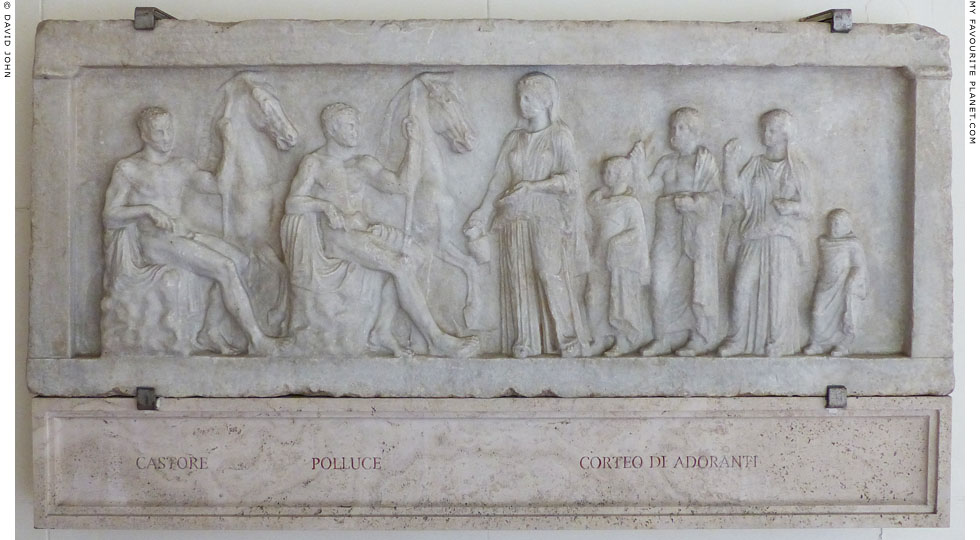
A marble votive relief with the Dioskouroi and a procession of worshippers.
Palazzo Altemps, National Museum of Rome. Inv. No. 182595. Brancaccio Collection.
|
On the left, Castor and Pollux sit on rock-hewn seats holding spears, with their horses at their sides. They face right, towards an approaching woman holding a wine jug and a phiale (libation bowl). Behind her a family of worshippers, a man and a woman holding ceremonial branches and two boys, depicted at a smaller scale, also approach the twins. The inscription below the relief is modern, museum labelling in stone.
The composition is based on a common type of Attic votive relief (see similar reliefs dedicated to Asklepios, Pan and the nymphs, Demeter, and Plouton and Persephone) and it is thought this may be a Greek original of the first half of the 4th century BC. Found in the area of the Horti Maecenatiani (Gardens of Maecenas), Rome, it may have belonged to a Roman collector. |
|
| |
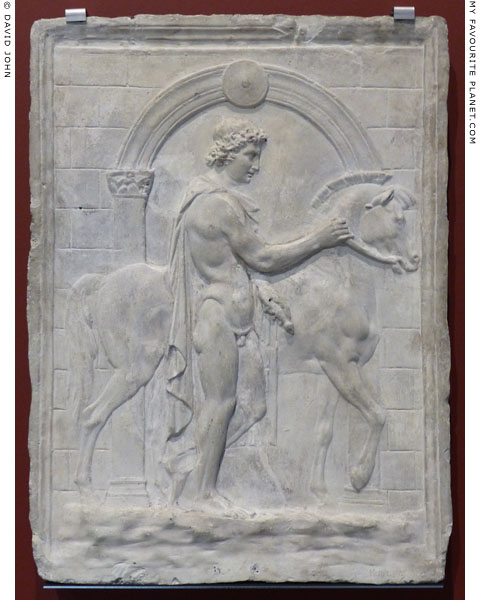
Plaster cast of a marble relief of one of the Dioscuri (a Dioskouros
or Dioscurus) leading a horse to the right, past an arched gateway.
The original is from the Roman Imperial period.
Height 82 cm, width 62 cm, depth 6 cm.
Abguss-Sammlung (Cast Collection), Semperbau, Dresden. Inv. No. ASN 4406.
|
So far I have discovered little about the original relief, which may be a Neo Attic work and is of fine quality. It is in the Pio Clementino Museum of the Vatican Museums, Rome, and according to the Dresden museums website is of the "middle of the Imperial period", presumably the 2nd century AD.
One of the 19th century catalogues of the Dresden Cast Collection describes the relief as "Castor with the horse" (Matthäy, 1831, Hautreliefs im fünften Fenster, Cat. No. 91, page 29). Two others claim it depicts Bellerophon with Pegasus before gates of Corinth (Chalybaeus, 1843, Reliefs im fünften Fenster, Cat. No. 52, page 37; Hettner, 1881, Cat. No. 139, page 105), although the horse does not appear to have wings.
For further information about the Dresden Cast Collection and
details of the catalogues see the note on the Niobe page.
For further information about Bellerophon and Pegasus
at Corinth, see the Herodes Atticus page. |
|
| |
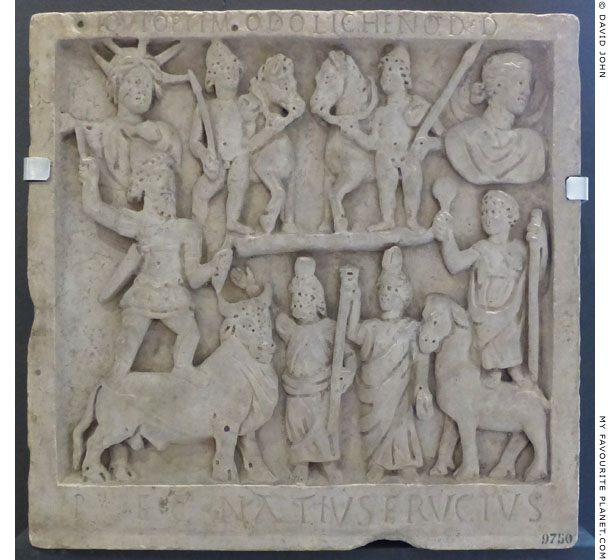
Inscribed marble votive relief showing the Roman deities Jupiter and
Juno Dolicheni with Isis, Serapis, the Dioscuri, Sol (Sun) and Luna (Moon).
Circa 250 AD. Excavated in July 1935 at the sanctuary of Jupiter Dolichenus on the
Aventine Hill, Rome [22]. Carrara marble. Height 57 cm, width 58.5 cm, thickness 7 cm.
Centrale Montemartini, Capitoline Museums, Rome. Inv. No. 9750.
|
The "oriental" Roman cult of Jupiter Dolichenus was often associated with those of other deities. In this relief, Jupiter (standing on a bull) and Juno (on a cow or hind) Dolicheni are depicted with four other divine couples related to the celestial and cosmic sphere. The bust of Sol (Sun, top left) wears a radiant crown, and behind Luna (Moon, top right) is a crescent. Castor and Pollux stand with horses and spears in the centre of the top row of figures. Below them stand the Egyptian gods Serapis and Isis.
On the frame of the marble slab, above and below the relief, is a two line dedication to Juno Dolicheni by Publius Egnatius Fructus:
Iovi Optimo Dolicheno d[ono] d[edit] (or d[e]d[icavit])
P[ublius] Egnatius Fructus
Inscription AE 1938, 0064 (1).
It has been suggested that the dedicator was a foreigner who took Roman citizenship and his Roman name from that of Emperor Gallienus (Publius Licinius Egnatius Gallienus Augustus, circa 218-268 AD), who was co-emperor with his father Valerian 253-260 and reigned alone 260-268.
See another relief of Jupiter and Juno Dolicheni on the Medusa page. |
|
| |
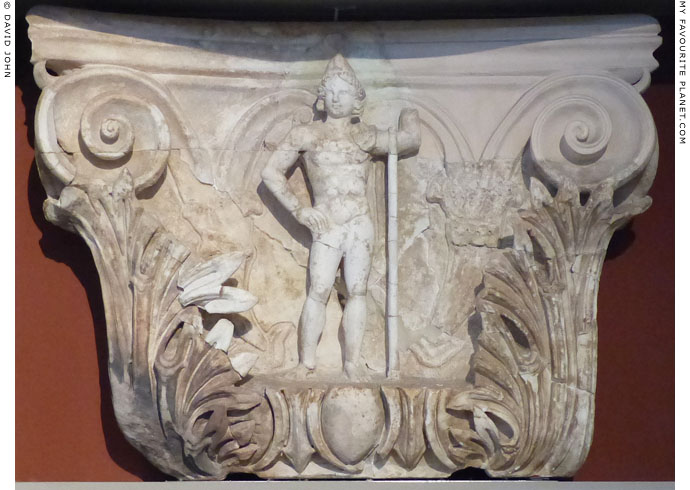
A relief of one of the Dioskouroi on the capital of a marble pseudopilaster
from the Octagon of the imperial palace complex, Thessaloniki.
Made in a Roman imperial workshop in the city, early 4th century AD.
The small dioskouros figure stands facing frontally, naked apart
from a pilos and cloak over his shoulders, holding an upright
spear with his left hand, and his right hand resting on his hip.
Thessaloniki Archaeological Museum. Inv. No. 6692.
See also a relief of the goddess Hygieia on another pseudopilaster
capital from the Thessaloniki Octagon on the Asklepios page. |
| |
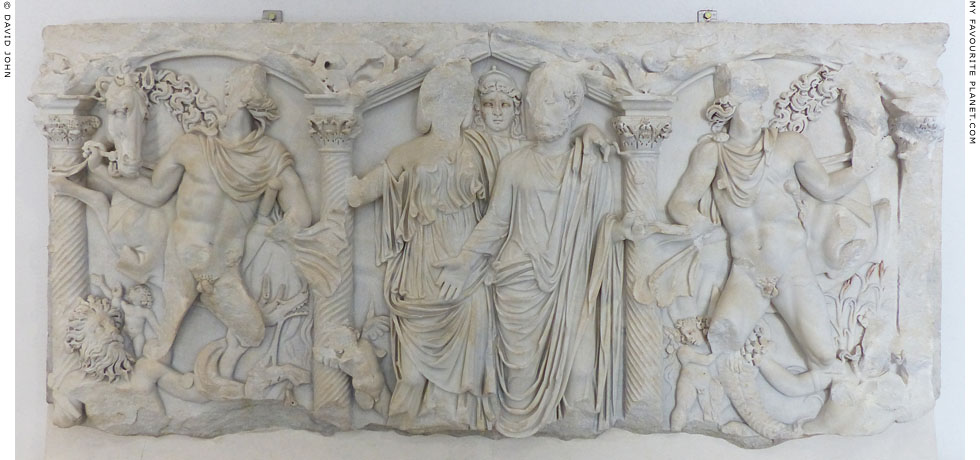
A relief on the front panel of a marble sarcophagus with an architectural setting,
depicting a married couple, behind whom stands a goddess wearing a diadem,
flanked by the Dioscuri with their horses, three erotes (cupids) and two river gods.
240-260 AD. From the Via Appia, Rome.
Palazzo Massimo alle Terme, National Museum of Rome. |
| |
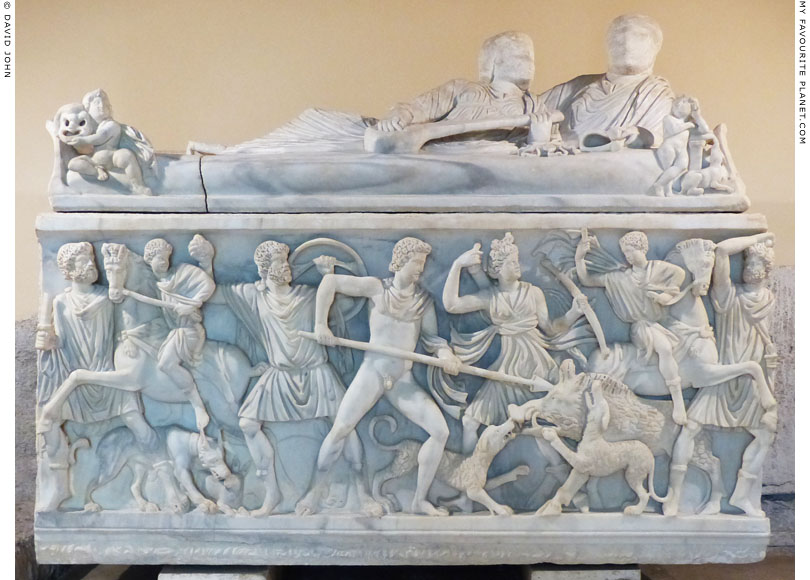
The Dioscuri taking part in the hunt of the Kalydonian Boar
on a relief on the front of a marble sarcophagus.
Late 2nd - early 3rd century AD. Proconnesian marble. Found in 1872 in a
tomb about 2 km from Vicovaro (ancient Varia, Latium), on the Via Valeria
from Tivoli, northeast of Rome. Height 125 cm, width 256 cm, depth 137 cm.
Lid height 79 cm (to top of heads), length 244 cm, depth 122 cm. Unrestored.
Palazzo dei Conservatori, Capitoline Museums, Rome. Inv. No. 917.
|
The complicated story of the hunt of the monstrous Kalydonian Boar (or Calydonian Boar; Greek, Καλυδώνιος Κάπρος, Kalydonios Kapros) features a Who's Who of Greek mythological characters, including Artemis, Meleager (the main hero of the myth), Peleus, the Argonauts, Asklepios, Atalanta, the Dioskouroi and Theseus. Several Roman period sarcophagi reliefs depicting the hunt have survived, showing that it was one of the popular mythical themes produced for the tombs of wealthy citizens keen to display their heroic virtue, religious inclinations and artistic and literary taste.
Artemis sent the boar to ravage the countryside of Kalydonia in Aetolia (central Greece), to punish the Kalydonian king Oineus (Οἰνεύς) [23] for forgetting to sacrifice to her. Oineus' son Meleager (Μελέαγρος, Meleagros) hunted the boar with several heroes and Atalanta (Ἀταλάντη, Atalante), the only female in the hunting party. Several of the group were killed by the beast which was first wounded by Atalanta and eventually finished off by Meleager's spear.
In Greek and Roman art the boar is sometimes shown as an enormous monster, but often shown smaller, at a more natural size. This may be due to considerations of space, particularly on reliefs, but also as part of the tradition of depicting gods and heroes, the main characters of scenes, as larger than mortals, minor characters and animals. This relief also shows the Dioscuri and their horses at a smaller scale than the other figures.
In the centre Meleager stabs the Kalydonian Boar with a spear. Atalanta, dressed as Artemis, the goddess of the hunt, stands next to him, holding a bow and drawing an arrow from her quiver. Castor and Pollux ride rearing horses at each side of the scene. Two hunting dogs attack the boar, and a third on the left menaces a crouching hare, behind which is a lower relief of a fallen antelope. The other three figures, bearded men wearing tunics, cloaks and hunting boots, appear to be the same person. One wonders whether the faces of the characters in the relief are portraits, perhaps of members of the family which commissioned or purchased the sarcophagus, a practice known from other reliefs such as on a sarcophagus depicting the Labours of Hercules in the Palazzo Altemps, Rome (Inv. No. 8642).
The lid is slightly shorter than the sarcophagus and may not originally have belonged to it. It is sculpted in the form of a couple reclining on a kline (couch). The woman, playing a stringed instrument, turns her head back to look at her husband. At each end of the front of the lid is a small Eros (Cupid). The figure on the left sits on the end of the mattress holding an actor's mask. At the right end an Eros stands leaning against a short pillar or altar, in front of which lies a panther. Both mask and panther indicate associations with the cult of Dionysus.
The heads of the reclining couple have been left unfinished. Such sarcophagi, some with stock designs and others with more elaborate reliefs, were made at a number of workshops around the Mediterranean, notably at Prokonnesos (today Marmara, Turkey) and Ephesus, and often shipped in a semi-finished state for sale in other cities, where presumably the features of the deceased where sculpted after purchase. On the other hand, the features of the couple may have been later erased for some reason. |
|
Pausanias described the temple of Athena Alea (Ἀθηνᾷ Ἀλέᾳ) in Tegea (Τεγέα), Arcadia, designed by Skopas and built around 345-335 BC. The pediment on the front (east side) of the temple was decorated with a depiction of the Kalydonian Boar hunt, featuring Polydeukes and Kastor attacking the monster from opposite sides.
"On the front gable is the hunting of the Calydonian boar. The boar stands right in the center. On one side are Atalanta, Meleager, Theseus, Telamon, Peleus, Polydeuces, Iolaus, the partner in most of the labours of Heracles, and also the sons of Thestius, the brothers of Althaea, Prothous and Cometes.
On the other side of the boar is Epochus supporting Ancaeus who is now wounded and has dropped his axe; by his side is Castor, with Amphiaraus, the son of Oicles, next to whom is Hippothous, the son of Cercyon, son of Agamedes, son of Stymphalus. The last figure is Peirithous.
On the gable at the back is a representation of Telephus fighting Achilles on the plain of the Caicus [see History of Pergamon].
The ancient image of Athena Alea, and with it the tusks of the Calydonian boar, were carried away by the Roman emperor Augustus after his defeat of Antonius and his allies [31 BC, see Athens Acropolis page 8], among whom were all the Arcadians except the Mantineans."
Pausanias, Description of Greece, Book 8, chapters 45-46. At Perseus Digital Library. |
|
|
| |
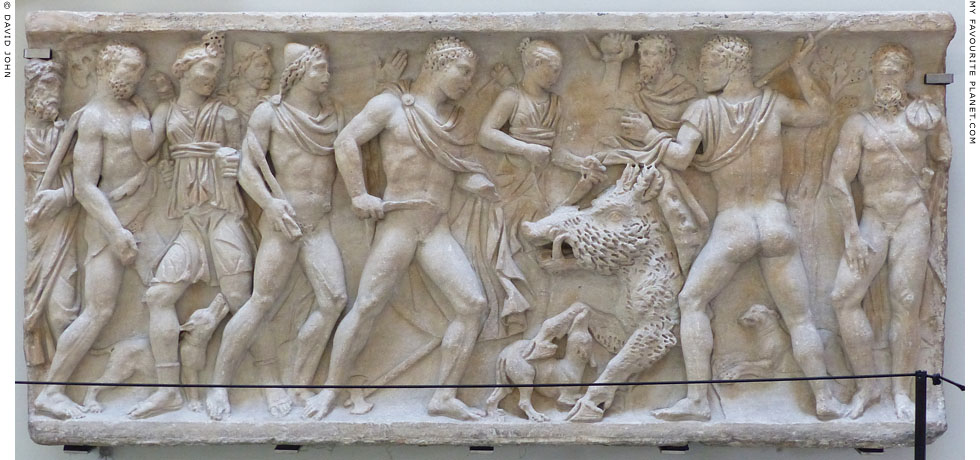
A panel from a marble sarcophagus with a relief depicting the Kalydonian Boar hunt.
Roman Imperial period, 150-250 AD. Greek marble. Height 85 cm, width 188 cm.
To the right of the boar, Meleager is about to thrust his spear into the creature.
To the left Peleus (or Theseus?) holds a sword. Behind him stands one of the
Dioscuri, naked apart from a pilos (πῖλος) conical cap and chlamys (short cloak).
The head of his brother can be seen behind him in lower relief.
Ashmolean Museum, Oxford. Inv. No. AD 1947.278.
From Naples. Acquired 1947 from the Sir Francis Cook Collection,
Doughty House, Richmond, southwest London. |
| |
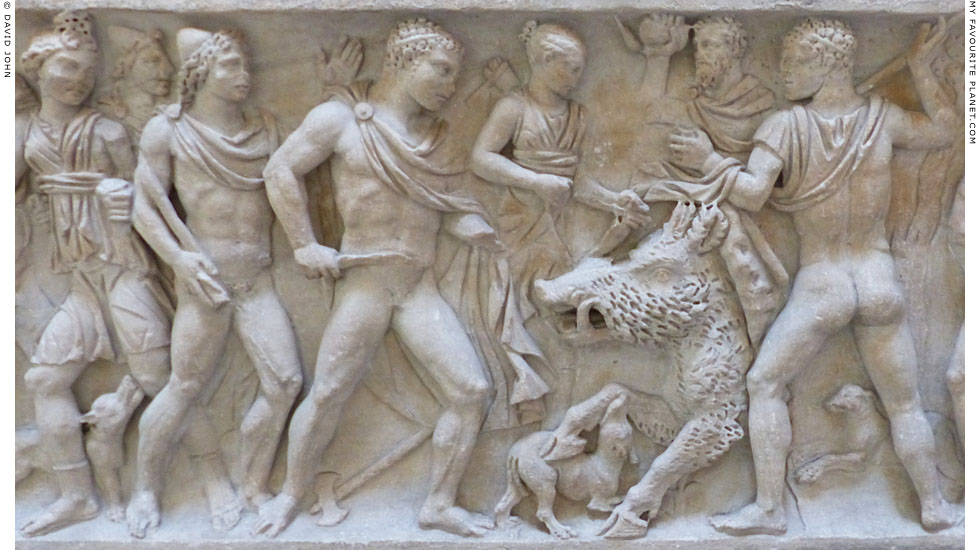
Detail of the relief in the Ashmolean Museum, showing Kastor and Polydeukes (left). |
| |

Kastor and Polydeukes taking part in the hunt of the Kalydonian Boar on a
relief on the front of an Attic marble sarcophagus from Eleusis, Attica, Greece.
Around 200 AD. Pentelic marble. Found in 1925 near the Roman bridge over
the Eleusinian Kephisos river. It was probably one of the many monuments
that stood along the sides of the Sacred Way between Athens and the
sanctuary of Demeter and Persephone at Eleusis.
Eleusis Archaeological Museum. Inv. No. 5243.
|
The Dioskouroi are side by side behind a boulder and plants, directly above the boar (see photo below). They face frontally with raised right arms that originally held spears with which they were stabbing the creature.
A dog attacks the boar from the left, while the other hunters and another dog approach it from the right. It appears to be biting the upper left arm of Ankaios, who sits on the ground and groans in pain. The hero Meleager, who will finally kill the beast, stands with his back to the viewer, thrusting with his spear. Behind him, the huntress Atalante takes an arrow from the quiver on her right shoulder. A river god and a smaller figure (Artemis?) watch the action from the far left.
The back of the sarcophagus is decorated with a relief of two Gryphons facing each other, while on the right narrow side is a Sphinx. The lid, which seems too small for the coffin, is in the form of a sloped roof with scale like tiles, akroteria at each corner, and pediments at each end. |
|
| |
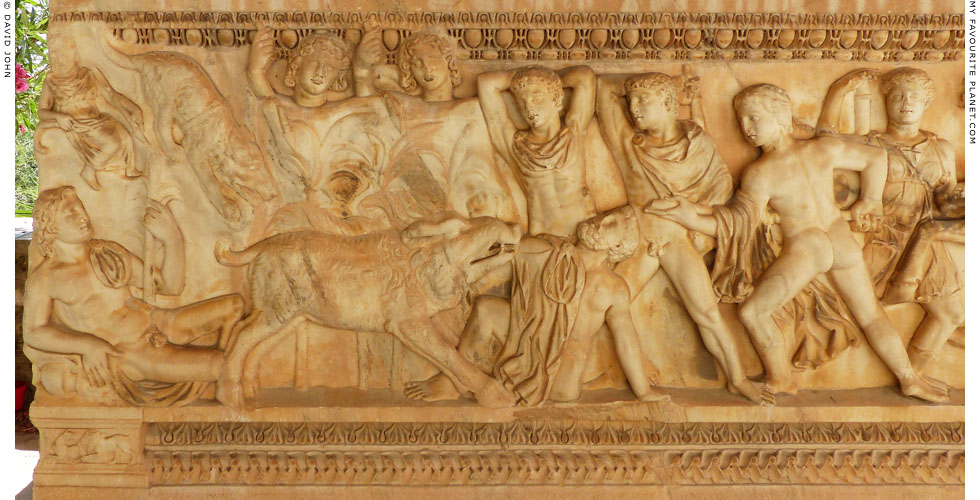
Detail of the Kalydonian Boar hunt relief in Eleusis. |
| |

The front of a Roman period marble sarcophagus with a relief showing the Dioscuri
taking part in the hunt of the Kalydonian Boar. Castor and Pollux stand with horses
just to the left of the centre of the scene. It was reused as the tomb of Caesar
Marullus (Cesare Marullo, died 1588), who was Bishop of Agrigento 1574-1577,
Archbishop of Palermo 1577-1588 and founder of the Seminary of Palermo.
The crypt of Palermo Cathedral, Sicily. |
| |
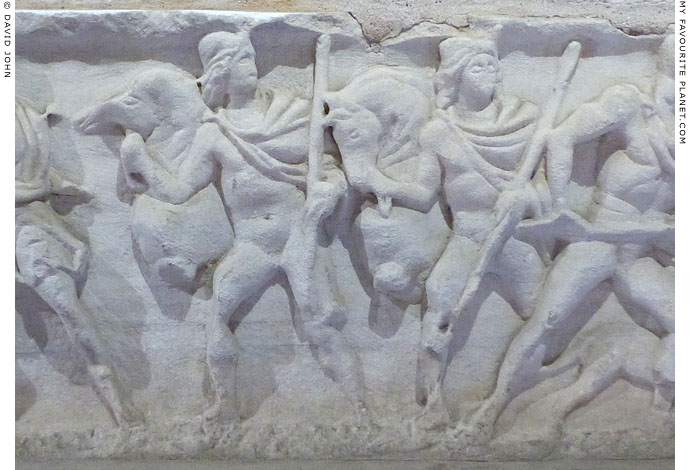
The Dioscuri on the sarcophagus in Palermo Cathedral, Sicily. |
| |
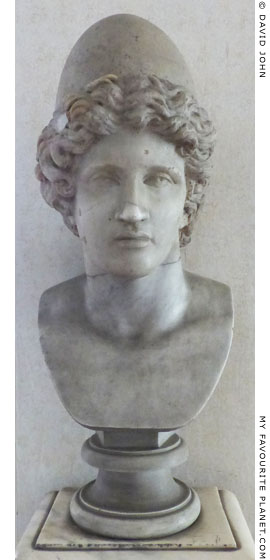
Unlabelled marbled bust, perhaps
modern (18th-19th century?) in the
Accademia dei Lincei, Trastevere, Rome. |
|
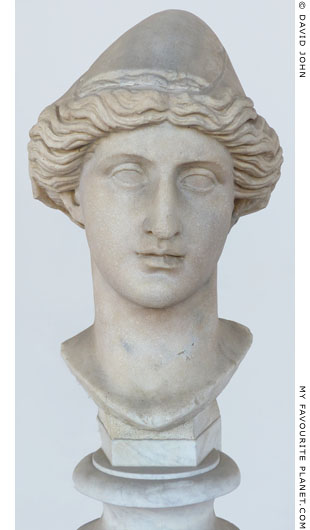
Unlabelled marble head in the cloister
of the Baths of Diocletian, National
Museum of Rome. |
|
| |
| Dioskouroi |
Notes, references and links |
 |
|
1. Dioskouroi and Dioscuri
On this page the names Dioskouroi, Kastor and Polydeukes are used for Greek contexts, and Dioscuri, Castor and Pollux for Roman contexts.
2. Leda's egg
Pausanias mentioned that in Sparta an object claimed to be Leda's egg was suspended from the roof of the temple of Hilaeira and Phoebe, the Leucippides [see note 4], who were worshipped there as goddesses. In an oblique way, this passage links the Leucippides with Leda, and thus with Helen and the Dioskouroi. He also said that a statue of one of the Leucippides had been "adorned" and given a new face by Leucippis, a priestess at the temple. It is not clear whether she did the work herself, or just paid for the renovation.
He continued with a ghost story in which the Dioskouroi appear in the house in Sparta where they had lived as mortals. The uncanny apparition is reminiscent of other legends concerning the twins, such as their appearances at the Battle of Lake Regillus and the Forum in Rome (see above).
"Near is a sanctuary of Hilaeira and of Phoebe. The author of the poem Cypria calls them daughters of Apollo. Their priestesses are young maidens, called, as are also the goddesses, Leucippides (Daughters of Leucippus). One of the images was adorned by a Leucippis who had served the goddesses as a priestess. She gave it a face of modern workmanship instead of the old one; she was forbidden by a dream to adorn the other one as well. Here there his been hung from the roof an egg tied to ribands, and they say that it is the famous egg that legend says Leda brought forth.
Each year the women weave a tunic for the Apollo at Amyclae, and they call Tunic the chamber in which they do their weaving. Near it is built a house, said to have been occupied originally by the sons of Tyndareus [the Dioskouroi], but afterwards it was acquired by Phormion, a Spartan. To him came the Dioscuri in the likeness of strangers. They said that they had come from Cyrene, and asked to lodge with him, requesting to have the chamber which had pleased them most when they dwelt among men.
He replied that they might lodge in any other part of the house they wished, but that they could not have the chamber. For it so happened that his maiden daughter was living in it. By the next day this maiden and all her girlish apparel had disappeared, and in the room were found images of the Dioscuri, a table, and silphium upon it."
Pausanias, Description of Greece, Book 3, chapter 16, sections 1-3. At Perseus Digital Library.
For further information for the statue of Apollo at Amyclae (Amyklai),
see Bathykles of Magnesia.
3. Nemesis as the mother of Helen of Troy
Pausanias wrote that the cult statue of Nemesis at the sanctuary of the goddess at Rhamnous (Ῥαμνοῦς), near Marathon, Attica, was made by Pheidias (according to other sources it was by Agorakritos of Paros). He described the relief on the pedestal of the statue as representing Leda leading Helen to Nemesis, attended by associated mythical figures, including Tyndareos and his children, as well as Agamemnon, Menelaos and Pyrrhus (also known as Neoptolemos), the son of Achilles.
"The Greeks say that Nemesis was the mother of Helen, while Leda suckled and nursed her. The father of Helen the Greeks like everybody else hold to be not Tyndareus but Zeus.
Having heard this legend Pheidias has represented Helen as being led to Nemesis by Leda, and he has represented Tyndareus and his children with a man Hippeus by name standing by with a horse. There are Agamemnon and Menelaus and Pyrrhus, the son of Achilles and first husband of Hermione, the daughter of Helen. Orestes was passed over because of his crime against his mother, yet Hermione stayed by his side in everything and bore him a child. Next upon the pedestal is one called Epochus and another youth; the only thing I heard about them was that they were brothers of Oenoe, from whom the parish has its name."
Pausanias, Description of Greece, Book 1, chapter 33, sections 7-8. At Perseus Digital Library.
4. The Dioskouroi, the Apharidae and Leucippides
The twin princes Lynkeus (Λυγκεύς) and Idas (Ἴδας), were sons of Aphareus (Ἀφαρεύς), who with his brother Leukippos (Λεύκιππος) was joint king of Messenia (Μεσσηνία), in the sothwestern Peloponnese. They were also said to be cousins of the Dioskouroi, as Tyndareos was also a brother of Aphareus and Leukippos. They are often referred to as the Apharidae (Ἀφαρηίδαι, Apharidi), Aphareidi, Aphareides, Apharetidae (Ἀφαρητίδαι, Apharetidai), Apharetides, or Apharetiadai (Ἀφαρητιάδαι).
Like the Dioskouroi, Lynkeus and Idas were also said to have been among Jason's Argonauts, and to have participated in the hunt of the Kalydonian Boar.
They were betrothed to their cousins, Hilaeira (Ιλάειρα, Softly Shining) and Phoebe (Φοίβη, Lunar Bright), the daughters of Leukippos and Philodike (Φιλοδίκη). The sisters, who were priestesses of Artemis and Athena, were known as the Leukippides (Λευκιππιδες, Daughters of Leukippos, or Of the White Horses). They were also said to be cousins of the Dioskouroi. In some versions of myths, Phoebe was their half sister.
Kastor and Polydeukes, charmed by the beauty of the Leukippides, abducted them and carried them off to Sparta. Each of the sisters had a son by one of the Dioskouroi: Hilaeira bore Anogon to Kastor and Phoebe bore Mnesileos to Polydeukes. In another version of the myths, the sons are named Anaxis and Mnasinous (Ἄναξις καὶ Μνασίνους). Lynkeus and Idas attempted to recover the sisters, but during the ensuing battle Kastor killed Lynkeus, then Idas killed Kastor, and finally Polydeukes killed Idas. Polydeukes persuaded Zeus to allow Kastor to share his immortality with his brother, and the sisters were also made immortal.
Pausanias noted that in the temple of the Dioskouroi in Argos stood statues of the Dioskouroi, their wives and sons by the Cretan sculptors Dipoenos and Skyllis:
"Going on a little further you see the grave of Argus, reputed to be the son of Zeus and Niobe, daughter of Phoroneus. After these comes a temple of the Dioscuri. The images represent the Dioscuri themselves and their sons, Anaxis and Mnasinous, and with them are their mothers, Hilaeira and Phoebe. They are of ebony wood, and were made by Dipoenus and Scyllis. The horses, too, are mostly of ebony, but there is a little ivory also in their construction."
Pausanias, Description of Greece, Book 2, chapter 22, section 5. At Perseus Digital Library.
See Hilaeira and Phoebe in a painting from Herculaneum on the Niobe page.
5. The "Homeric Odes"
Despite their name, the collection of thirty three songs in praise of Greek gods, known as the "Homeric Hymns" (Ὁμηρικοὶ ὕμνοι, Homerikoì hymnoi), were not written by Homer, and their authors and dates remain unknown. It is thought that individual hymns may have been written some time between the seventh and fourth centuries BC, some perhaps even later.
A number of editions and translations of the "Homeric Odes" can be read online, including.
Hugh G. Evelyn-White (translator and editor), Hesiod, the Homeric Hymns and Homerica (contents page), translated into English prose. Loeb Classical Library edition. Harvard University Press, Cambridge, MA and William Heinemann Ltd., London, 1914 (reprinted 1920). At Wikisource.
6. The foundation of Tyndaris
"After the disaster which the Carthaginians had suffered, the survivors from the cities of Sicily that had been enslaved gathered together, gained back their native lands, and revived their strength. Dionysius settled in Messene a thousand Locrians, four thousand Medmaeans, and six hundred Messenians from the Peloponnesus who were exiles from Zacynthus and Naupactus. But when he observed that the Lacedaemonians were offended that the Messenians whom they had driven out were settled in a renowned city, he removed them from Messene, and giving them a place on the sea, he cut off some area of Abacaene and annexed it to their territory. The Messenians named their city Tyndaris, and by living in concord together and admitting many to citizenship, they speedily came to number more than five thousand citizens."
Diodorus Siculus, The library of history, book 14, chapter 78, sections 4-6. At Bill Thayer's LacusCurtius website.
7. Meleager of Gadara on the etymology of cyclamen
William Roger Paton (1857-1921), translator, The Greek anthology Volume I (of five), Book IV, The poems of the different anthologies, 1. "The Stephanus of Meleager" ("The introduction to Meleager's Garland"), page 113. William Heinemann, London; G.P. Putnam's sons, New York, 1916. At archive.org.
8. Double heads on coins from Istros
A number of alternative suggestions have been made to explain the double heads on coins from Istros. For example: that they represent Apollo or Helios as the rising and setting sun; or the supposed two branches of the river Danube (or Ister); or two different winds.
9. Metopes of the Sikyonian monopteros, Delphi
The five surviving metopes (mostly fragments), in the order they are exhibited in the Delphi museum (left to right):
1. A figure on the back of a large ram, possibly Helle or Phrixos riding the Golden Ram in the myth of the Golden Fleece.
2. A large boar, probably the Kalydonian Boar, below which is a relatively tiny dog;
3. A woman on a bull, probably Europa on Zeus;
4. Idas following Kastor and Polydeukes (names inscribed) with cattle;
5. The ship Argo with two musicians, Orpheus (inscribed) on the right, the other unidentifiable, and the Dioskouroi on horseback on either side (Polydeukes inscribed, on the left). |
|
|
|
10. The "Kleobis and Biton" kouros statues at Delphi
When the first statue was unearthed it was recognized as one of the earliest large-scale Archaic kouroi. However, the subsequent discovery of its twin caused considerable confusion, followed by a great deal of speculation. It was apparently Homolle who, recalling the passage from Herodotus, identified the figures as Kleobis and Biton. An early reading of the inscriptions on the bases ([κλεοβις και βι]τον | ταν ματαρα ...) appeared to confirm the identification, which was generally accepted.
The inscriptions have since been reexamined and discussed by several scholars. Two of the most recent studies, by Claude Vatin (1981) and Paul Faure (1985), independently concluded that the statues were dedications to the Dioskouroi. Their conclusions are discussed in an article by David Sansone, who argues that even if Vatin and Fauré are correct in claiming that the inscriptions mention the Dioskouroi, wanakes (kings, from ϝάναξ, an early form of ἄναξ; the name by which the Dioskouroi were worshipped in Argos) and even Polydeukes, the statues may still be depictions of Kleobis and Biton dedicated to the Heavenly Twins.
See:
Claude Vatin, Monuments votifs de Delphes. In: Bulletin de correspondance hellénique, Volume 106, livraison 1, 1982, pages 509-525. At Persée.
Paul Faure, Les Dioscures à Delphes. In: L'antiquité classique, Tome 54, 1985, pages 56-65. At Persée.
David Sansone, Cleobis and Biton in Delphi. Nikephoros 4 (1991), pages 121-132. At academia.edu.
Andrew Stewart is one of those who prefer Agamedes:
"Before Hageladas, the only known Argive sculptor is [Aga]medes, who signed the twins at Delphi ca. 580 (Delphi, Kleobis and Biton; Stewart 1990, figs. 56-57)."
Hageladas of Argos in the chapter The Archaic Period. In: Andrew Stewart, One Hundred Greek Sculptors, Their Careers and Extant Works. At Perseus Digital Library.
11. The Heraion of Argos
The Heraion of Argos (Ηραίον Άργους) is 9.5 km northeast of Argos (Άργος), at an elevation of 120 metres on the steep southwestern slope of Mount Euboea. The archaeological site is visible high above the Argive plain from the road between Corinth and Argos.
12. Kleobis and Biton
Cicero (106-43 BC) on Kleobis and Biton: Cicero's Tusculan disputations, Book 1, section 47, pages 60-61. Translated by Charles Duke Yonge. Harper & Brothers, New York, 1888. At the Internet Archve.
Diogenes Laertius (3rd century AD) also assumed that the story was well-known to his readers, showing that it had continued to capture popular imagination for at least six centuries, possibly for over 800 years. Perhaps the brothers deserve an MFP People page to themselves.
"There Croesus put the question, 'Whom do you consider happy?' And Solon replied, 'Tellus of Athens, and Cleobis and Biton,' and went on in words too familiar to be quoted here."
Diogenes Laertius, Lives of the Eminent Philosophers, Book 1, chapter 2, section 50. At Perseus Digital Library.
Pausanias mentioned a relief depicting the brothers pulling their mother's cart, opposite the sanctuary of Nemean Zeus at Argos (Άργος).
"Hard by are Cleobis and Biton carved in relief on stone, themselves drawing the carriage and taking in it their mother to the sanctuary of Hera."
Pausanias, Description of Greece, Book 2, chapter 20, section 3. At Perseus Digital Library.
The scene is also known from a number of Roman period coins of Argos and a gem now in the Berlin State Museums (see images above), a relief on an altar in the Baths of Diocletian, Rome (see photo, above right) and a marble relief in the National Archaeological Museum, Venice (see image below).
Earlier in Book 2 (chapter 19, section 5), Pausanias had noticed a statue of Biton, presumably the same person, standing in Argos. Citing a lost work by the local antiquary and poet Lykeas (Λυκέας, known only from four mentions by Pausanias), he related another feat of piety and strength in which Biton carries a sacrificial bull to the sanctuary of Zeus at nearby Nemea (Νεμέα), home of the panhellenic Nemean Games.
"Here is dedicated the throne of Danaus, and here is placed a statue of Biton, in the form of a man carrying a bull on his shoulders. According to the poet Lyceas, when the Argives were holding a sacrifice to Zeus at Nemea, Biton by sheer physical strength took up a bull and carried it there."
This further mention of Biton alone seems to suggest that there may have been other legends or myths about at least this brother. It appears to have attracted little comment by modern scholars, although it has been assumed by some that the two brothers may have been the subject of a hero cult. As far as I know there is no other known surviving mention of the brothers not related to the story of their death.
Herodotos does not name the mother of Kleobis and Biton, but in a passage attributed to Plutarch (fragment 133) she is called Kydippe (Κυδίππη; Latin, Cydippe).
"Trophonius and Agamedes, having built a temple at Delphi, asked Apollo for their reward. He replied that he would give it them six days later; and six days later they died. Again, Cydippe, the mother of Cleobis and Biton, prayed to Hera to give her sons whatever might be her finest gift, because they had harnessed themselves and drawn their mother to the goddess's temple; they immediately passed away. Someone has composed an epigram on them as follows:
'Here lie Biton and Cleobis, who placed a yoke on their own shoulders and drew their mother to the shrine of Hera. The people envied her for having such fine children for her sons, and she in her joy prayed to the goddess that her sons might be allotted the best of fortunes, since they had done this honour to their mother. And thereupon they laid them down to sleep and departed life in their youth, showing this to be the best and most blessed thing there is.'"
Plutarch, from the work A woman, too, should be educated, fragment 133; Stobaeus, iv. 52. 43 (v, p. 1085 Hense). In: Plutarch's Moralia Volume 15: Fragments. In Greek with an English translation by F. H. Sandbach, pages 246-249. Loeb Classical Library edition. Harvard University Press, Cambridge, MA. and William Heinemann Ltd, London, 1987.
The name Kydippe also appears in the Anthologia Palatina (Greek Anthology, Book 3, section 18, at Attalus) and Dio Chrysostom, Discourse 64, "On Fortune II" (at LacusCurtius). Hyginus, Fabulae 254, "Those who were exceptionally dutiful", sections 5-7 (at ToposText), also called her Cydippe, but referred to the brothers as Cleops and Bitias. In the Byzantine Greek encyclopedia the Suda (e.g. entry § ka.2499 Κροῖσος: Croesus, Kroisos, at ToposText) she is referred to as Kydippe or Theano (Θεανὼ). The latter is thought to be an archetypal name for Greek priestesses taken from the "fair-cheeked Theano, daughter of Cisseus, the wife of Antenor", the Trojan priestess of Athena in Homer, Iliad, Book 6, lines 298-312. |
| |
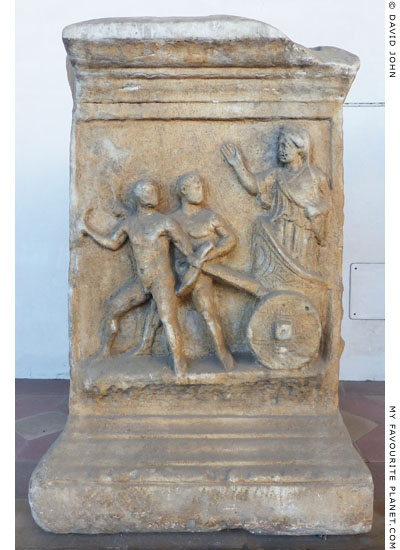
Relief on the front of a marble altar depicting
Kleobis and Biton pulling their mother's wagon,
here in the form of a chariot.
Roman Imperial period. Found in 1942 in the Via della
Giustiniana, Rome. Height 75 cm, width 50,5 cm.
A relief on the left side of the altar shows Artemis and
Acteon, and on the right side Dionysus or Hippolytus.
Baths of Diocletian, National Museum of Rome.
Inv. No. 121983. |
| |
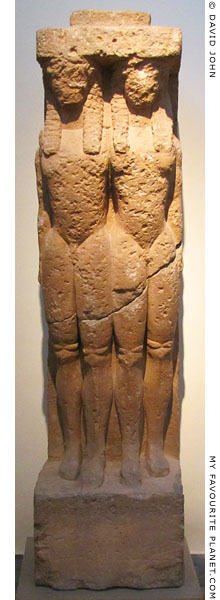
An inscribed grave stele with a high relief of two
youths standing side by side and embracing. They
step forward in the manner of kouroi statues.
Found at Tanagra, Boeotia, central Greece.
Made in a Boeotian workshop, around 500-525 BC.
Boeotian poros (limestone). Height 200 cm,
width 42 cm (top), 53 cm (bottom), height of
figures 147 cm, maximum depth of relief 27 cm.
An unusual stele, one of the earliest known Greek funerary monuments. The work is badly damaged, with a long diagonal crack around halfway up. The figures' bodies and thighs are pitted and the faces completely destroyed.
A name is inscribed along the side of the outside leg of each figure: Dermys (left) and Kytilos (right). An epigram inscribed on the base, written in an epichoric (local) alphabet, records that the stele was erected by Amphalkes on the grave of Kytilos and Dermys. It is thought that the relief may depict the deceased, who were perhaps brothers. The 5 cm high rectangular socket at the top of the stele was probably for the attachment of a crowning sculptural ornament, perhaps a seated Sphinx.
|
Left figure: Δέρμυς Right figure: Κιτύλος
On the base:
Ἀμφάλκες ἔστασ’ ἐπὶ Κιτύλοι ἐ|δ’ ἐπὶ Δέρμυι
Amphalkes erected this monument
over the graves of Kittylos and Dermys.
Inscription IG VII 579 (also: CEG I 109;
SEG 19:336; Jeffery, LSAG 92, 94, no. 8)
National Archaeological Museum, Athens. Inv. No. 56. |
| |
| |
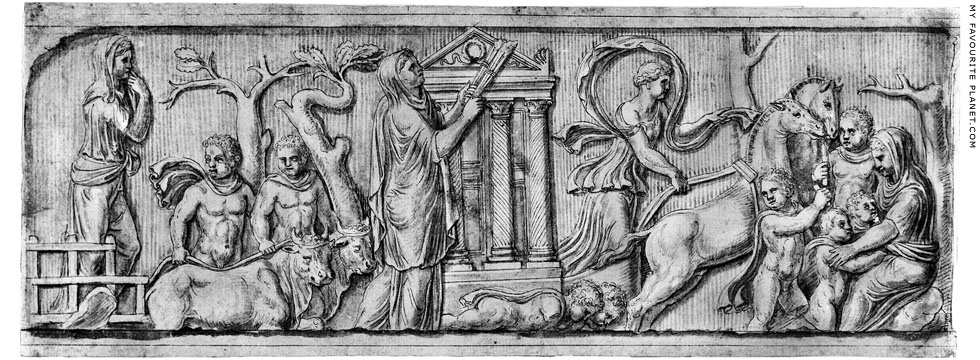
A relief on a marble cover for a funerary loculus (niche) from Rome,
thought to depict the myth or legend of Kleobis and Biton.
Mid 2nd century AD. Height 65 cm, width 146 cm, depth 10 cm.
National Archaeological Museum, Venice. Inv. No. 235.
From the collection of Giovanni Grimani.
|
The figures on the left of the relief have been identified by some scholars as Kleobis and Biton leading their mother's ox cart on the way to the Heraion of Argos. However, this identification has been challenged by other scholars. Strangely, the oxen are also shown, although it was supposed to have been their absence that led to the brothers' heroic feat of filial and pious devotion (Herodotus, Histories, Book 1, chapter 31). They are shown here as young children or infants, perhaps meant as portraits of deceased Roman children whose funerary monument this may have been. It was not unusual on Roman funerary monuments for deceased family members to be depicted as legendary or mythological characters.
In the central scene the veiled mother is shown standing in front of a temple (presumably the Temple of Hera), holding a torch in each hand. The two children lie in front of her, either asleep or dead. To the right of the temple a female figure (probably a goodess, Hera) drives a horse-drawn chariot in front of which stand what appear to be the two children. On the right end of the relief, two children, shown at a smaller scale, are embraced by the mother, who is shown seated on a rock in front of a tree with its branches cut. This final scene has been interpreted as their reunion in the afterlife.
The marble slab is not, as stated in some publications, part of a sarcophagus, but was the cover for a loculus (Latin, little place), a wall niche used as a grave. Although originally recorded as being in Rome, in 1586 the relief entered the large collection of antiquities gathered by the wealthy Venetian bishop Giovanni Grimani (1506-1593), patriarch of Aquileia (1545-1550 and 1585-1593), who housed it in the Palazzo Grimani di Santa Maria Formosa, Venice. In 1587 he donated the collection to the city of Venice.
The print above is from the Codex Coburgensis, a collection of prints from drawings by one or more unknown artists of ancient sculptural works in Rome and the surrounding area. Compiled around 1550-1555, it has been described as "the first systematic archaeology book". It was among the collections of the dukes of Coburg, today known as the Veste Coburg Art Collections, kept on the castle grounds of the Veste Coburg, Coburg, Germany.
See:
Henning Wrede, Richard Harprath, Der Codex Coburgensis, No. 65 (page 82). Joachim Kruse, Coburg, 1986. PDF of the entire work (plates only, no text; around 446 megabytes!) downloadable at arachne.dainst.org.
Hans Dütschke (1848-1928), Antike Bildwerke in Oberitalien, Band V: Antike Bildwerke in Vicenza, Venedig, Catajo, Modena, Parma und Mailand, Cat. no. 292, pages 111-112. Wilhelm Engelmann, Leipizig 1882. At the Internet Archive.
Carl Robert (editor), Die antiken Sarkophagreliefs 3,3 (Dritte Band, Dritte Abteilung): Einzelmythen: Niobiden - Triptolemos ungedeutet, Cat. no. 438, pages 531-533 and Tafel CXLII. G. Grote'sche Verlagsbuchhandlung, Berlin, 1919. |
|
| |
13. Samnite and Hoplomachus gladiators on lamps
A number of ceramic lamps have been found with depictions of fights between two types of gladiator, identified as a Samnite and a hoplomachus (ὁπλομάχος, literally, shield fighter), both of which are often described as having been "heavily armed", with helmets, shields, body and leg armour and swords (the hoplomachus also carried a spear). There are a number of variants of the scene, but the combatants are usually shown with the armour and arms associated with the respective type of gladiator.
See for example:
An inscribed lamp in the British Museum, the discus of which is has a combat between a Samnite and a hoplomachus, and the inscription names two gladiators "ACVVIVS.V HERMEROSS" (Acuvius and Hermeros). Made in Italy, 51-100 AD. Said to be from Pozzuoli, Naples. Inv. No. 1856,1226.472.
www.britishmuseum.org/collection/object/G_1856-1226-472
See also a 3rd century AD marble relief of a gladiatorial duel
between a hoplomachus and a thraex from Ephesus.
14. The horos in Corfu
A short article on the column with a drawing was published in: Andrea Mustoxidi, Delle cose corciresi, Volume Primo, inscription LXXXII, pages 252-253. Tipogr. del governo, Corfu, 1848. At Googlebooks. (No further volumes were published.)
For further information about the Corfiot historian Andreas Moustoxydis (Ανδρέας Μουστοξύδης, 1785-1860), see the note in Medusa part 3.
See also:
Hermann Roehl, Inscriptiones graecae antiquissimae (often abbreviated IGA), No. 345, page 81. Georg Reimer, Berlin, 1882. At the Internet Archive.
Ernest Stewart Roberts, An introduction to Greek epigraphy, Part 1, No. 101, page 130. Cambridge University Press, 1887. At the Internet Archve.
The drawing of the Lexeiatas inscription (though not the Dioskouron inscription) also appeared in: Hermann Roehl, Imagines inscriptionum Graecarum antiquissimarum, 4th edition, X28, page 48. Georg Reimer, Berlin, 1907. At the Internet Archive.
15. Lekanis
A lekanis (Λεκανίς; plural, λεκανίδες, lekanides) is a type of shallow ceramic bowl with a lid, two horizontal handles and a wide foot. They are thought to have been given as wedding gifts, and to have been used by women for storing jewellery, cosmetics and other objects. A lekane (λεκάνη; plural, λεκάναι, lekanai) is similar but has no lid and is often undecorated. |
|
|
|
16. The Incantadas in Thessaloniki
The architect and traveller James Stuart (see Athens Acropolis gallery page 12), who was in Thessaloniki 1753-1754, reported on Las Incantadas, and related a local legend which had grown up around it that included Alexander the Great, a Thracian king and his beautiful wife, a magician from Pontus, and the philosopher Aristotle also as a magician:
"We had visited such objects of curiosity as our inquiries could discover at Thessalonica before we left it; but, although it is a large and populous city, said at that time to contain 100,000 inhabitants, we found the remains of only one building, the description of which we could flatter ourselves would interest the lovers of ancient art.
This is situated in the Jews' quarter; five Corinthian columns on their pedestals support an entablature, over which is an attic adorned with figures in alto-relievo; on the side next the street are a Victory, a Medea, or, perhaps a Helen, with a diadem and sceptre, a Telephus, and a Ganymede; and, next the court-yard of the Jews' House, a Bacchante dancing and playing on the flute, a Bacchus, a Bacchante crowned with vine leaves, and a Leda.
It seems difficult, if not impossible, to ascertain the species of building of which this ruin once made a part; for though the figures I have specified would seem to be proper decorations for a theatre, no traces were discovered that might confirm the opinion these figures suggested; nor does the vulgar tradition of the place afford any light, that may assist our inquiries. I will, however, relate the account they give, just as I received it, since it will give the reader some idea of the present Greeks, shew their propensity for the marvellous, and the facility with which, from a few given circumstances, they can make out a wonderful story.
This building they call Goeteia [c] (Gohteia, enchantment) or the Incantada, and affirm it to have been the work of magic art. On being asked when, and on what occasion, this extraordinary fact was performed, they answered, the fact was undoubted; every body knew that their great king Alexander conquered Persia. When he was preparing to invade that empire, he solicited the assistance of a king of Thrace, who accordingly united his forces to those of his Macedonian neighbour attending in person, with his family, at the court of Alexander, where they were royally entertained, and lodged in a sumptuous palace near his own, communicating with it by means of a magnificent gallery, of which these columns are the remains.
The Thracian queen, a lady of transcendant beauty, accompanied her husband on this visit. Alexander, young, and unaccustomed to control his passions, ardent in the pursuits of love as of glory, dazzled with such excess of charms, determined to violate the rights of hospitality, and seduce the queen of Thrace. He contrived, by means of this gallery, to pay her frequent visits, though not so privily as to escape the notice of her husband, who, having verified his suspicions, resolved to take a dreadful revenge on the deluder. He had in his train a skilful necromancer from Pontus, who, discovering by his art the instant that Alexander was to pass to the queen's apartment, scattered his spells and charms throughout this gallery; they were of such marvellous power, that whoever should, at a certain hour, attempt to pass, would inevitably be converted into stone.
Aristotle, a conjurer attached to Alexander, and of skill greatly superior to the man of Pontus, discovered his danger time enough to prevent it: by his advice and entreaties, Alexander was prevailed on to forbear for once his appointed visit. The impatient queen, tired with expectation, sent one of her confidential servants to see if her lover was coming, and she herself soon followed. At this instant, the king, supposing the magic had worked all its effect, issued forth, attended by his conjuror, to feast his eyes with a sight of the revenge he had taken; when, strange to relate, both companies, those with the king, as well as those with the queen, were instantly changed to stone, and remain to this hour a monument of vengeance on a jealous husband and an unfaithful wife."
From the editor's notes:
b "By the dates of Stuart's journal, it appears that he was upwards of six months in Salonica, from the 28th of September, 1753, to the 20th of April, 1754; how he was chiefly occupied there does not appear, since Revett, who rejoined him about the 18th of February, 1754, made the architectural drawings from 'Las Incantadas.' This ruin standing in the quarter inhabited by the Jews, who are descended from Spanish refugees settled there, and consequently speak Spanish, it is on that account named by them according to the latter termination, meaning 'The enchanted figures.' [ed.]"
c "No traveller, either fraught with most extensive learning, or eminent in antiquarian research, has been enabled to give even a plausible appropriation to this ruin. Pococke viewed it as a triumphal monument. Villoison describes it as the entrance of a theatre; he says, 'c'étoit surement l'entree de quelque théatre où l'on célebroit les jeux'; and Dr. Clarke terms it 'the Propylaea of the ancient Hippodrome or of the Forum.' All these descriptive appellations have no fixed character of application through the medium of this ruin, to any known ancient edifices of those classes..."
James Stuart and Nicholas Revett, The antiquities of Athens, measured and delineated, Volume 3 ("new edition"), Chapter XI: Of a Ruin at Salonica called 'The Incantadas', pages 119-124, Plates 45-49. Priestly and Weale, London, 1827. At Heidelberg University Digital library.
The drawing of the Dioskouros relief, signed by Stuart, is Plate VIII, in the first edition, in which the illustrations are more detailed than in the 1827 edition. Revett's drawing of the north side of the colonnade, showing the relative positions of the reliefs, is Plate II.
James Stuart and Nicholas Revett, The antiquities of Athens, measured and delineated, Volume 3, Chapter IX: Of a Ruin at Salonicha called the Incantada, pages 53-56, plates I-XIII. John Nichols, London, 1794. At the Internet Archive.
Although Revett made the architectural drawings of the monument, the scenic drawing of Las Incantadas above is signed by Stuart.
See also:
Paul Perdrizet, L'«Incantada» de Salonique (Musée du Louvre). In: Monuments et mémoires de la Fondation Eugène Piot, Tome 31, fascicule 1-2, 1930, pages 51-90. At Persée.
The English doctor and traveller Dr Henry Holland (1788-1873), who visited Thessaloniki 29th November - 5th December 1812, described the Incantadas in his account of his tour through Albania and Greece:
"In the middle of the city, a singular ruined structure is seen, forming in its present state the entrance to the area of a Greek house, - a Corinthian colonnade, of which four columns now remain, supporting an entablature, on which are corresponding pilastres, six feet in height. On each side of this upper colonnade are four figures in full length, now so far defaced by time, that it is not easy to make out all their characters. It seems probable, however, that three of those on one side represent Victory, Bacchus, and Ganymede; while on the other side are the figures of Leda and Ariadne, a male figure, and that of a female in profile. This edifice is supposed to have been the entrance of the ancient circus of Thessalonica; and if so, the scene of the dreadful massacre directed by Theodosius. It is stated, though I know not on what authority, to have built in the time of Nero. It does not appear that the columns ever exceeded five in number."
Dr Henry Holland, Travels in the Ionian Isles, Albania, Thessaly, Macedonia, etc. during the years 1812 and 1813, chapter XV, page 318. Longman, Hurst, Rees, Orme and Brown, London, 1815.
Herman Melville, the author of Moby Dick, also wrote that he saw Las Incantadas during his short stay in Thessaloniki in December 1856, but mentioned only the columns and not the reliefs. A detailed description of the colonnade was written on 24 August 1828 by the Austrian diplomat Graf Anton Prokesch von Osten (1795-1876), who considered it the most beautiful ancient monument in the city.
Ritter Prokesch von Osten, Denkwürdigkeiten und Erinnerungen aus dem Orient, Band 3 (Volume 3 of 3), pages 642-644, "Salonich, am 24. August 1828". Hallberger'sche Verlagshandlung, Stuttgart, 1837. At the Internet Archive. |
|
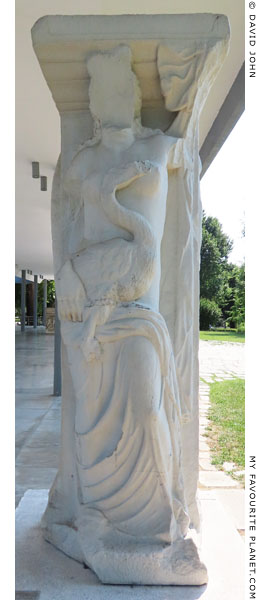
The replica of the pilaster from
"Las Incantadas" with a relief
of Leda and the swan (Zeus).
Thessaloniki Archaeological Museum.
Original, Louvre, Paris.
Inv. No. Ma 1394. |
|
|
17. Strymon, the river and river god
The sources of the 415 kilometre long Strymon river (Ancient Greek, Στρυμών; modern Greek, Στρυμόνας, Strymonas) are on the south slopes of the Vitosha mountain in Bulgaria, south of Sofia. It flows southwards for 290 kilometres, enters Macedonia, Greece, flows through Amphipolis (Ἀμφίπολις) and into the Strymonic Gulf of the Northern Aegean Sea at the site of Eion (Ἠϊών), the ancient port of Amphipolis. A lake formed by the river at Amphipolis, drained in the 20th century, was once known for its excellent-tasting eels, which during the Ottoman period were fished exclusively for the sultan's palace in Istanbul.
Strymon is thought to be an ancient Thracian name. Areas of tribal Thrace around the Northern Aegean coast were colonized by Greeks from around the 10th century BC, with a second, larger wave of colonization in the 8th - 6th centuries BC (see History of Stageira and Olympiada part 2). Later, many parts of western Thrace were gradually conquered by the Macedonians, particularly by Philp II (ruled 359-336 BC), who extended Macedonian territory to east of the Strymon (see History of Stageira and Olympiada part 6).
Depictions of the river god Strymon (Στρυμών) are rare, and the few short references to him by ancient authors differ in details, some of which contradict other accounts. Like many Greek river gods, Strymon was said to be the son of Okeanos (Oceanus) and Tethys. He was a Thracian king and the father of the Thracian heroes Olynthos (Ὄλυνθος), Brangas (Βράγγασ) and Rhesos (Ῥῆσος), by one of the Muses, either Euterpe or Calliope. By Neaera (Νέαιρα) he was also the father of Evadne (Εὐάδνη), wife of Argos, king of Argos in the Peloponnese.
Olynthos was either the mythical founder of the city of Olynthos in Halkidiki (see History of Stageira and Olympiada parts 5 and 6), or was killed by a lion during a hunt and buried there by his brother Brangas. According to another version of the myth, Olynthos was a son of Herakles and the goddess or nymph Bolbe (Βόλβη) who lived in the lake of the same name (modern Lake Volvi), around 30 km west of the Strymon.
Homer mentioned Rhesos as a king of Thrace who was killed by Odysseus and Diomedes at Troy (Iliad, Book 10, see Homer part 2), but wrote that his father was Eioneus (Ἠιονεύς). The name may be the mythological eponym of the Thracian city Eion at the mouth of the Strymon. On hearing of the death of his son, Strymon is said to have drowned in the river which was renamed after him. This story is similar to that of the Aegean Sea being named after King Aegeus of Athens who drowned himself when he thought that his son Theseus was dead (see Athens Acropolis gallery page 11).
18. Aulus Postumius Albus and the Dioscuri
The exact dates of Aulus Postumius Albus' life and dictatorship are uncertain. He is thought to have been dictator in 499, 498 or 496 BC when he commanded the Roman forces at the Battle of Lake Regillus. The story of the Dioscuri's miraculous appearances and their intervention on the side of the Romans at the battle may be a later explanation for the origin of their temple in the Forum.
Aulus Postumius Albus was also said to have been responsible for the establishment of Rome's first temple of Ceres (Demeter, another Greek deity, adopted by the plebeians), following a vow he made during a famine around 496 BC (see Demeter and Persephone). These legendary events and the introduction of new religious institutions in the city occurred shortly after the foundation of the Roman Republic around 509 BC.
19. The temple of the Dioscuri near the Circus Flaminius
There are only two brief mentions of this temple by ancient authors. One of them, Vitruvius, merely noted that its unusual architectural form was similar to that of temples of Athena on the Athenian Acropolis and at Sounion:
"There are also other kinds of temples, constructed in the same symmetrical proportions and yet with a different kind of plan: for example, the temple of Castor in the district of the Circus Flaminius, that of Vejovis between the two groves, and still more ingeniously the temple of Diana in her sacred grove, with columns added on the right and left at the flanks of the pronaos. Temples of this kind, like that of Castor in the Circus, were first built in Athens on the Acropolis, and in Attica at Sunium to Pallas Minerva. The proportions of them are not different, but the same as usual. For the length of their cellae is twice the width, as in other temples; but all that we regularly find in the fronts of others is in these transferred to the sides."
Vitruvius, Ten books on architecture, Book 4, chapter 8, section 4. Translated by Morris Hicky Morgan and Albert A. Howard. Harvard University Press and Oxford University Press, 1914. At the Project Gutenberg
20. Dimensions of the "Leda sarcophagus" in Kifissia
As with many artworks and archaeological objects, various publications state different dimensions, often without citing their sources, or making it clear whether the authors have measured the objects themselves.
The data provided by Arachne, the central object database of the Deutsches Archäologisches Institut (DAI, German Archaeological Institute) and the Archäologisches Institut der Universität zu Köln (Archaeological Institute of the University of Cologne), often differs from other sources. It gives the following dimensions for the sarcophagus: Height 110.5 cm, width 323 cm, depth 88 cm.
145665: attischer Sarkophag: Helena und die Dioskuren. Leda. At arachne.
21. The Dioscuri stele in Turin
See the online collection database of the Museo Egizio (Egyptian Museum) website:
Stele dedicata a Castore e Polluce... at collezioni.museoegizio.it.
Here the stele is said to be of limestone and dated to around 30 BC - 395 AD, while according to other sources it is sandstone and from the 1st - 3rd century AD. It certainly looks like dark red sandstone. The dating has been discussed in a number of publications, and a short bibliography is given on the Turin museum database page.
See also: Dirk Koßmann, Ägyptische Götter in Panzertracht in der römischen Kaiserzeit, Anhang 3, Dio 3. Stele, page 674. Köln, 2014. A short entry on the stele with bibliography, in an edited version of his dissertation, University of Köln, 2012. PDF in German at CORE open access research papers.
22. Jupiter Dolichenus and the Aventine Hill
The epiphet Dolichenus is taken from the ancient city of Doliche (Greek, Δολίχη) today the village of Dülük, around 10 km north of Gaziantep city centre and 50 km west of Euphrates river, in south-central Turkey, near the border with Syria. The syncretic mystery cult is thought to have been developed by Roman soldiers from the local Hadad-Baal-Teshub cult from around the 1st century BC, when they conquered much of this area and incorporated it into the Roman province of Syria. Like Jupiter Dolichenus, the Anatolian and Mesopotamian weather gods Teshub and Hadad were sometimes represented holding a weapon, such as a double axe, in one hand, and a thunderbolt in the other, and standing with or on a bull.
By the 2nd century the Jupiter Dolichenus cult had spread through the Roman Empire, and is known from inscriptions and other artefacts found in Germania, Britannia, Dacia, Pannonia, north Africa, Italy and Rome. It reached the height of its popularity during the 3rd century, when this relief was made, after which it declined rapidly.
The cult is not mentioned by ancient authors, and since, like other mystery cults such as the Eleusinian Mysteries (see Demeter and Persephone), its secrets were revealed only to the intitiated, nothing is known of its beliefs, rites or practices. It appears that its initiates actively recruited and that it was in competition with other "oriental" syncretic cults, particularly that of Mithras.
The modern term dolichenum, for a sanctuary or temple of Jupiter Dolichenus, was coined by archaeologists, although the word dolicenum is mentioned in at least one inscription. There were three sanctuaries of Juno Dolichenus in Rome. Those on the Esquiline Hill and Caelian Hill are thought to have been military establishments, while that on the Aventine Hill, founded during the reign of Antoninus Pius (138-161 AD), was for civilians.
Although the existence of the Aventine dolichenum was known from regionary catalogues of the 4th century, it was discovered by chance in 1935 during the digging of a drain on the Via di San Domenico, between the churches of Santi Bonifacio e Alessio and Santa Sabina. During subsequent excavations, the remains of an open sanctuary which had later been roofed over were unearthed. Among artefacts discovered there was an altar and a large number of inscriptions, statues and reliefs. As at other sanctuaries of the cult, objects were found which included representations of other gods, such as Diana, Isis, Serapis, Mitra, Sol, Luna and the Dioscuri, who were also worshipped at shrines on the Aventine.
This relief is sometimes referred to as Inv. No. 6745, which was presumably its old invoice number before it was moved to the Centrale Montemartini museum.
See:
Elmar Schwertheim, Corpus Cultus Iovis Dolicheni (CCID). E. J. Brill, Leiden, 1987. This relief is No. 386, pages 253-254, Tafel LXXXVII.
See also:
Charles S. Sanders, Jupiter Dolichenus, in Journal of the American Oriental Society, Volume 23, pages 84-92. New Haven, Connecticut, 1902. At the Internet Archive. A short introduction to the cult and study of Jupiter Dolichenus. At the Internet Archive.
Pinar Kuşseven, The cult of Iupiter Dolichenus: origins and iconography. M.A. thesis. Department of Archaeology and Art History, Bilkent University, Ankara, 2007. PDF. With bibliography. At the Bilkent University website.
Joachim Pahl, Der Kult des Jupiter Dolichenus - Ausbreitung, Selbstverstandnis, Niedergang - Auf der Basis statistischer Erhebungen und mit einem erganzenden Corpus, pages 160-162 and Tafel XXIV, EC 61. Inaugural dissertation, Westfalischen Wilhelms-Universitat zu Munster, 2010. At the Internet Archive. With bibliography. At the Internet Archive.
23. King Oineus of Kalydonia
Oineus was the father of Meleager, Deianeira, Toxeus, Clymenus, Periphas, Agelaus, Thyreus (or Phereus or Pheres), Gorge, Eurymede, Mothone, Perimede and Melanippe. According to other versions of myths, Meleager's father was Ares, and Deianeira (the wife of Herakles) was the daughter of Dionysus.
He was credited with introducing winemaking to Aetolia. In a story similar to those concerning other legendary or mythical heroes in places around the Greek world, he was taught the arts of viniculture and winemaking by Dionysus. See, for example, the story of Ikarios introducing viniculture to Attica. |
|
|
| |
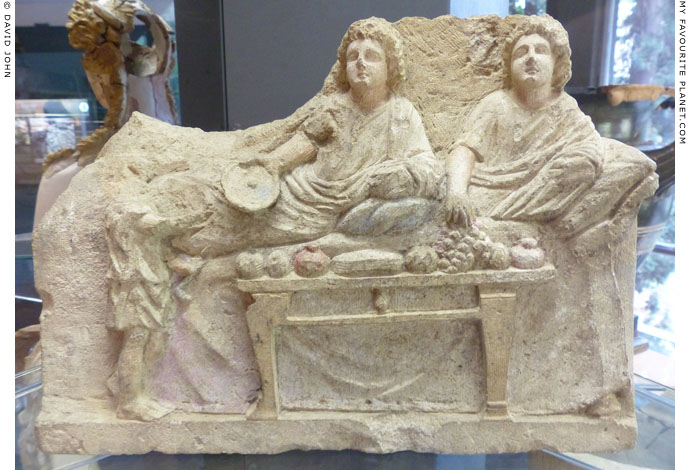
A limestone relief showing a banqueting scene with two almost identical young men reclining
on a kline (couch). It is thought to be a funerary monument for two heroized youths, perhaps
brothers. The youth on the left holds out a phiale (libation bowl) to a serving boy (oinochoos,
wine-pourer). The table in front of the kline is laden with food. Traces of colour are still visible.
Hellenistic period, 3rd century BC. From Syracuse, Sicily.
Paolo Orsi Regional Archaeological Museum, Syracuse. |
| |
Photos on this page were taken during
visits to the following museums:
Germany
Dresden, Albertinum, Skulpturensammlung
Dresden, Semperbau, Abguss-Sammlung
Speyer, Historisches Museum der Pfalz
Greece
Amphipolis Archaeological Museum, Macedonia
Athens, National Archaeological Museum
Athens, Numismatic Museum
Corfu Archaeological Museum
Delphi Archaeological Museum
Drama Archaeological Museum, Macedonia
Rhodes, Palace of the Grand Master
Thasos Archaeological Museum, Macedonia
Thessaloniki Archaeological Museum, Macedonia
Italy
Milan, Civic Archaeological Museum
Naples, National Archaeological Museum
Paestum, National Archaeological Museum
Rome, Accademia dei Lincei
Rome, Capitoline Museums, Palazzo dei Conservatori
Rome, Capitoline Museums, Palazzo Nuovo
Rome, National Museum of Rome, Baths of Diocletian
Rome, National Museum of Rome, Palazzo Altemps
Rome, National Museum of Rome, Palazzo Massimo alle Terme
Rome, Roman Forum archaeological site
Italy - Sicily
Agrigento Regional Archaeological Museum
Palermo Cathedral
Syracuse, Paolo Orsi Regional Archaeological Museum
Netherlands
Leiden, Rijksmuseum van Oudheden
Turkey
Istanbul Archaeological Museum
United Kingdom
London, British Museum
Oxford, Ashmolean Museum
Many thanks to the staff of these museums. |
|
| Photos and articles © David John, except where otherwise specified. |
 |
Visit the My Favourite Planet Group on Facebook.
Join the group, write a message or comment,
post photos and videos, start a discussion... |
|
|
| |
| Copyright © 2003-2025 My Favourite Planet | contributors | impressum | contents | sitemap |
| |






























































































